RAF Bovingdon - 1960s
I remember the winter of 1962/3 well! Having left Bovingdon at the end of the summer of 1962, I went on a Transport Command Ground Course at Thorney Island, which was a waste of time. After that it started to snow and I continued to Whitworth Gloster Coventry for an Argosy Ground School Course followed by a Rolls Royce Dart Course at Derby. We finished off the groundschool in February 1963 at RAF Benson, but the Wing Commander flying had buggered up the snow clearance badly, so as the runway was still unusable we took two Argosies, which were stuck at RAF St Mawgan, to Malta and Tripoli where we did three weeks of type conversion flying.
A Tenuous Link With Drift
I was once more hunting around for scraps under the table involving Bovingdon when my eyes alighted upon this:
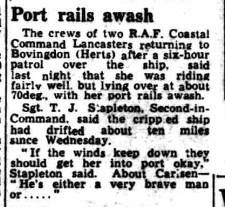
Bradford Observer 4 January 1952 (BNA).
Now I remember at the time that my Dad remarked that Capt Carlsen was a very brave Man..........

Northern Daily Mail 28 December 1951 (BNA)
The earliest Newspaper Reports were of this date. The Story was yet break. 'Flying Enterprise' was steaming from Hamburg for The United States. On Christmas Night 1951 she encountered, in the Radio Operator's words, a " severe Hurricane" that caused structural damage and a subsequent cargo shift. The World would watch while events unfolded over the next fortnight.

The Sphere (BNA)

Western Mail 3 January 1952 (BNA)
This appears to be one of the first aerial press photos dating from 2 January 1952.
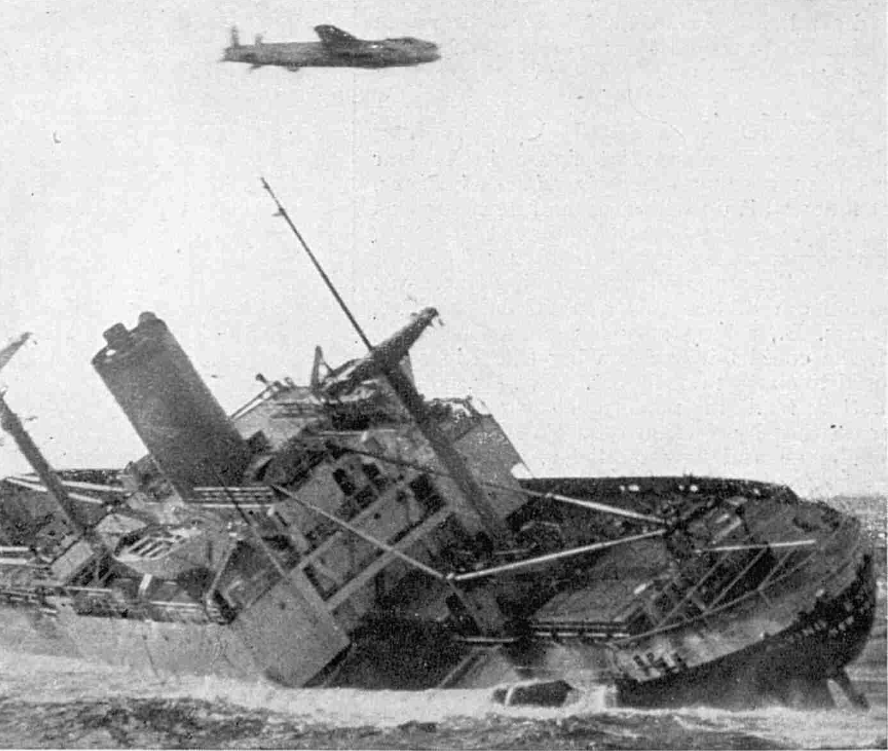
The Sphere (BNA)
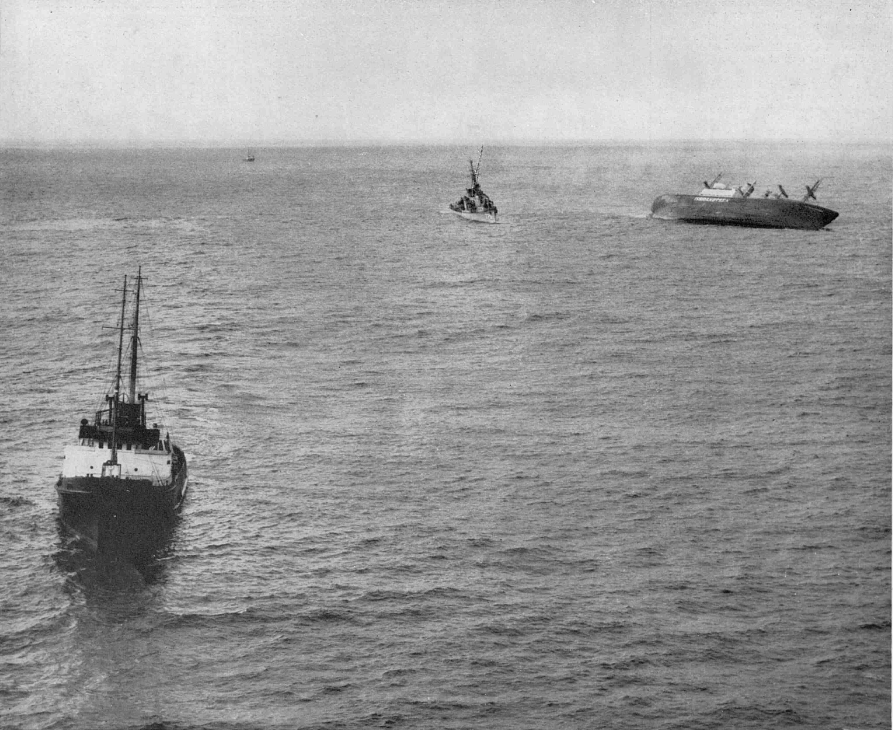
The Sphere (BNA)
'The Flying Enterprise' is under tow by The Admiralty Tug 'Turmoil' with the Destroyer 'USS John Weeks' in attendance.
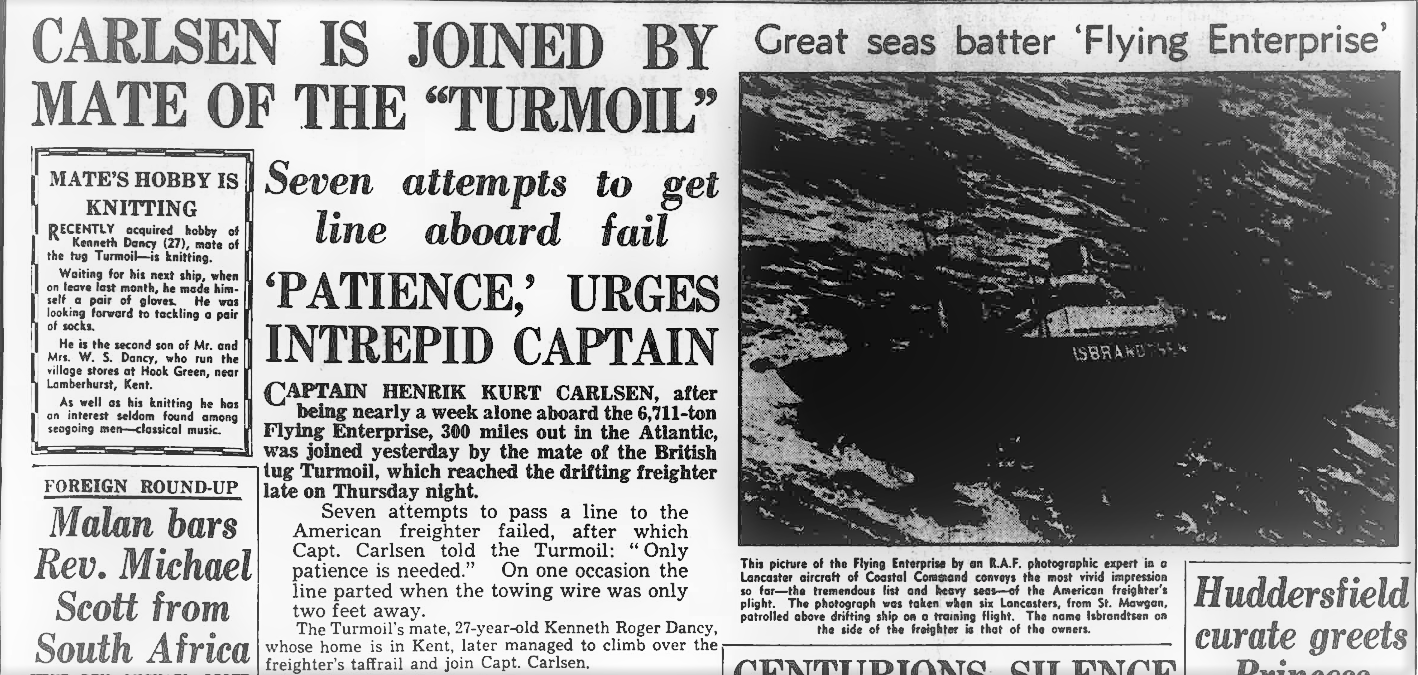
Yorkshire Observer 5 January 1952 (BNA)

Lancaster ASR3s from St Eval participated. I think probably the Coastal Command Lancasters that came to Bovingdon (Why - proximity to Northwood?) were from St Eval and patrolling over 'The Flying Enterprise' on January 3rd. They would have been from either 203 or 210 Squadrons. I couldn't find a decent snap of a ASR3 from St Eval. This image is from 37 Squadron - not sure of location but probably Malta.
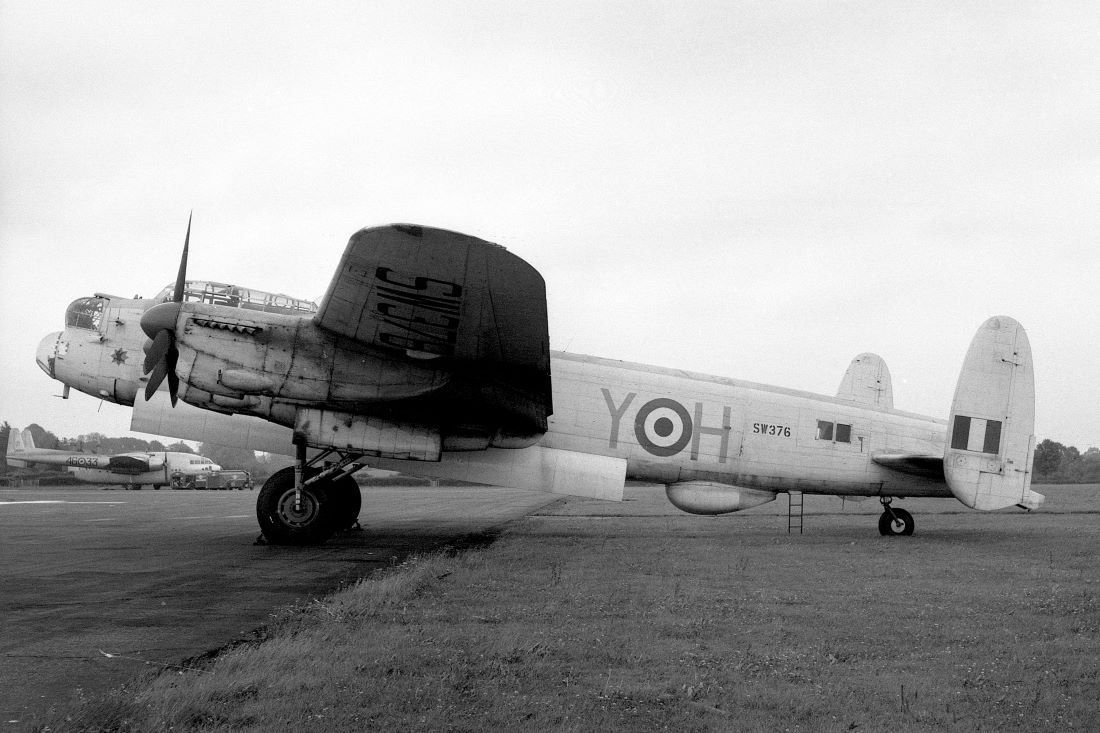
Lancaster GR3s from The School of Maritime Reconnaissance, St Mawgan were very active too. The fate of 'The Flying Enterprise' was too good an opportunity to pass up for a spot of training ! This particular GR3 of the SMR was photographed at Bovingdon and fits into a time frame between 1953 (when C119s came into Italian Air Force Service) and 1956 when the Lancaster was retired from Service.
If it is a poor night for Telly you might enjoy these videos: I think this first one was filmed from an Anson.
This next one is good but doesn't tell what happened after the tow was underway......
https://www.britishpathe.com/asset/171687/
This one completes the story.......

Bradford Observer 4 January 1952 (BNA).
Now I remember at the time that my Dad remarked that Capt Carlsen was a very brave Man..........

Northern Daily Mail 28 December 1951 (BNA)
The earliest Newspaper Reports were of this date. The Story was yet break. 'Flying Enterprise' was steaming from Hamburg for The United States. On Christmas Night 1951 she encountered, in the Radio Operator's words, a " severe Hurricane" that caused structural damage and a subsequent cargo shift. The World would watch while events unfolded over the next fortnight.

The Sphere (BNA)

Western Mail 3 January 1952 (BNA)
This appears to be one of the first aerial press photos dating from 2 January 1952.

The Sphere (BNA)

The Sphere (BNA)
'The Flying Enterprise' is under tow by The Admiralty Tug 'Turmoil' with the Destroyer 'USS John Weeks' in attendance.

Yorkshire Observer 5 January 1952 (BNA)

Lancaster ASR3s from St Eval participated. I think probably the Coastal Command Lancasters that came to Bovingdon (Why - proximity to Northwood?) were from St Eval and patrolling over 'The Flying Enterprise' on January 3rd. They would have been from either 203 or 210 Squadrons. I couldn't find a decent snap of a ASR3 from St Eval. This image is from 37 Squadron - not sure of location but probably Malta.

Lancaster GR3s from The School of Maritime Reconnaissance, St Mawgan were very active too. The fate of 'The Flying Enterprise' was too good an opportunity to pass up for a spot of training ! This particular GR3 of the SMR was photographed at Bovingdon and fits into a time frame between 1953 (when C119s came into Italian Air Force Service) and 1956 when the Lancaster was retired from Service.
If it is a poor night for Telly you might enjoy these videos: I think this first one was filmed from an Anson.
This next one is good but doesn't tell what happened after the tow was underway......
https://www.britishpathe.com/asset/171687/
This one completes the story.......
Last edited by OUAQUKGF Ops; 29th Mar 2023 at 19:48. Reason: correction
How Green Was My Valley
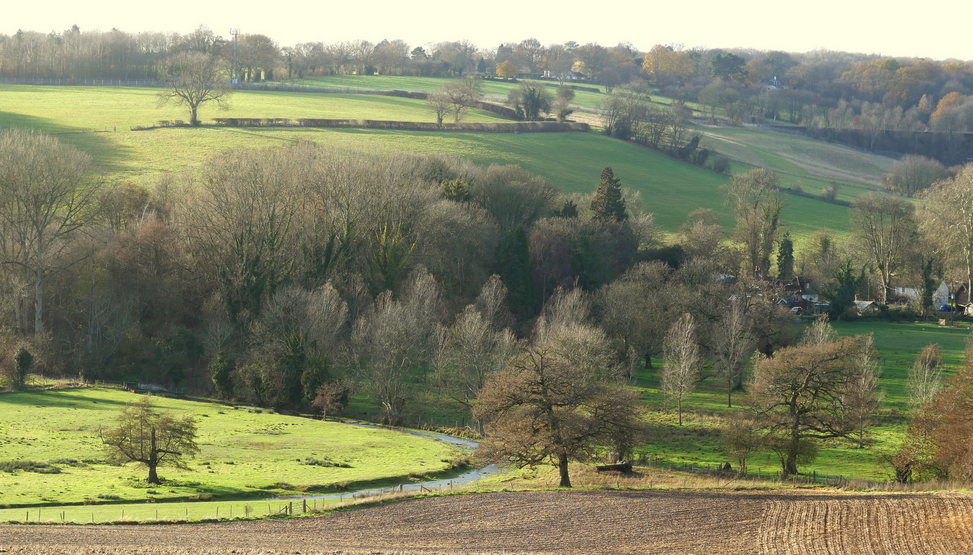
The Chess Valley. Photo Doug Kennedy.
My early childhood days were spent in the Chiltern Hills near Chalfont St Peter between the wide, open valley of the River Misbourne and slightly further afield, the mysterious and lush little valley of the River Chess. I crossed the River Misbourne each day as I walked with my Mother to Infants School. In some seasons the river would be dry and at other times deep enough to allow bathing. The Misbourne valley there, was wide, mostly of bland water-meadows with a few tired old Willows. Far more interesting were the skies overhead where DC4s and Constellations, sparkling high in sunlight, circled overhead waiting for the fog to burn off at London Airport. If at that time my Father was flush we might have had an Old Banger. We certainly had a Pony and Trap and while they were well suited to the tight little lanes that eventually dropped down to the narrow valley of the River Chess it was not considered wise to take a pony on to the dispersals of an active airfield such as Bovingdon where I was taken to play on the Halifax hulks. To descend to the Chess at Latimer was in high summer to enter another world shadowed by huge Willows where flashes of white light reflected from the clear chalk stream, whilst small fishes darted and Kingfishers called.

23 May 1951. Manchester Evening News. (BNA)

12 September 1952. Bucks Examiner. (BNA)
I'm afraid the standard of reproduction is so poor here that I'm having to transcribe the text.. I have to say that this article, which is by The Editor, must have been written during a period when there was no other 'NEWS'......
' A VAST AMOUNT OF TRAFFIC.
Following a vast number of complaints received from local inhabitants on the Chesham side of Bovingdon Airport the Bucks Examiner contacted The Air Ministry and The Ministry of Aviation resulting in an invitation by The Commandant, Wing Commander Hilton to visit the aerodrome and have their position and difficulties explained and pointed out in a practical manner. It is unlikely that many people in the area realise what a vast amount of traffic is dealt with at Bovingdon. During the past year (1952) traffic has almost doubled to about 2000 movements (arr/dep) per month and in one day they have had as many as 150. The Ministry of Civil Aviation are landlords of the Airport and rent it out to several private companies while it is also used by the RAF to a certain extent - there are about half a dozen jets, Meteors and Vampires stationed there.
PLANES OVER THE CHESS VALLEY - THE REVERBERATION.
One of these companies brought into use, two or three months ago (at a date which coincides with the beginning of the complaints), 15 York Aircraft. They carry between 40-50 passengers are powered by four Rolls Royce Merlin engines and are occupied mainly in Trooping Flights. Consequently, when loaded, these planes take a longer time to climb than many, and as the runway chiefly used at the airport runs north and south, their take-off will very often bring them directly over Chesham. Likewise, having taken off on the west-east runway, the secondary one, planes often have to circle southwards again bringing them over the Chess Valley. This applies also, of course, to planes landing. The peak hours are the morning departures and the late afternoon arrivals. Another point to be borne in mind is that Chesham, lying as it does in a valley receives the noise reverberated from side to side.'
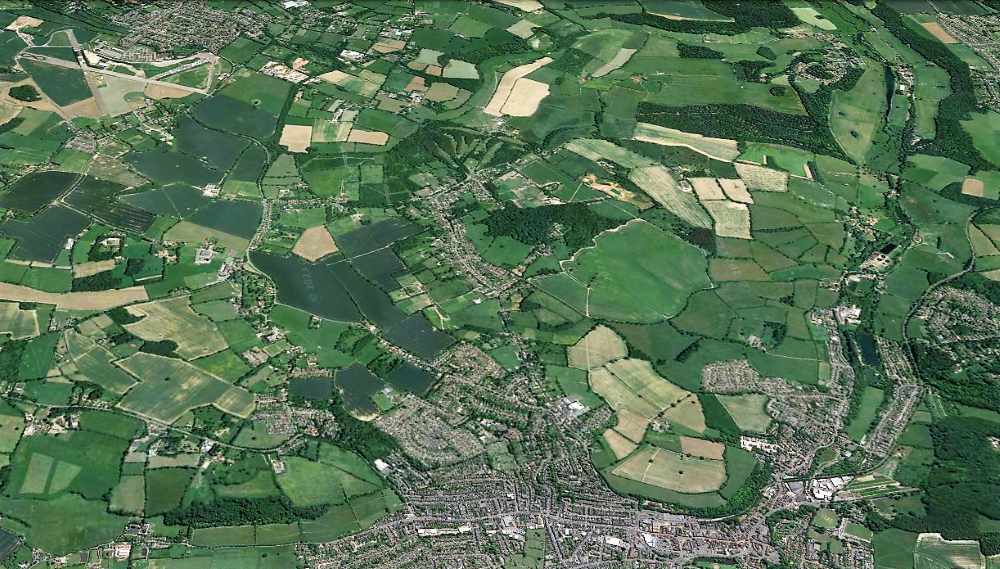
The outskirts of Chesham today in relation to Bovingdon. The Chess valley runs vertically on the RHS . The small bright white square is, I think a marquee, at Latimer. Close by to Latimer House where during WW11 aircraft noise was a potential problem for Latimer's eavesdropping activities. (see page 23 #424)
I'm afraid that the rest of the article is almost completely illegible but the gist of it is reads that the Airport Authority emphasize that no low flying laws have been infringed and furthermore they hint that the Avro Yorks may soon be moving elsewhere. (August 2023 I've added a scarce second's worth of newsreel which shows a Skyway's York departing from the shorter Runway 27 towards Chesham in 1952 ). Link follows below.
https://www.britishpathe.com/asset/254532/
.

26 September 1952. Bucks Examiner. (BNA)
So much for the vast number of complaints ! I cannot be sure that the BNA have a complete run of the 'Bucks Examiner' but I have combed it from July 1951 until December 1952 and this is the only letter and article on the subject of aircraft noise from Bovingdon that I can find. LAC Yorks came into service in July 1951 that company purchasing Skyways (in whose livery these Yorks were flown) in March 1952. In October 1952 Skyways moved from Bovingdon to Stansted.
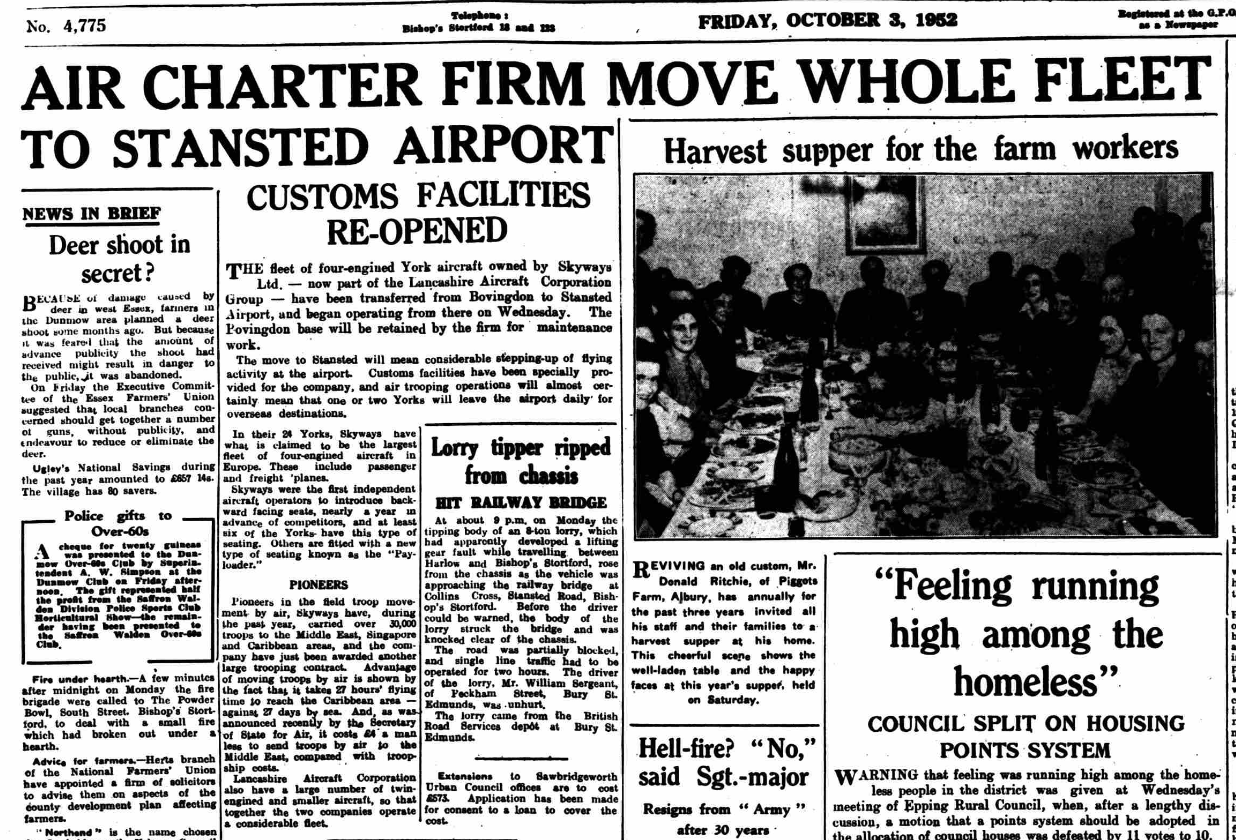
3 October 1952. Herts and Essex Observer.(BNA)

Avro York G-AHEY Skyways. Photo Wikimedia.
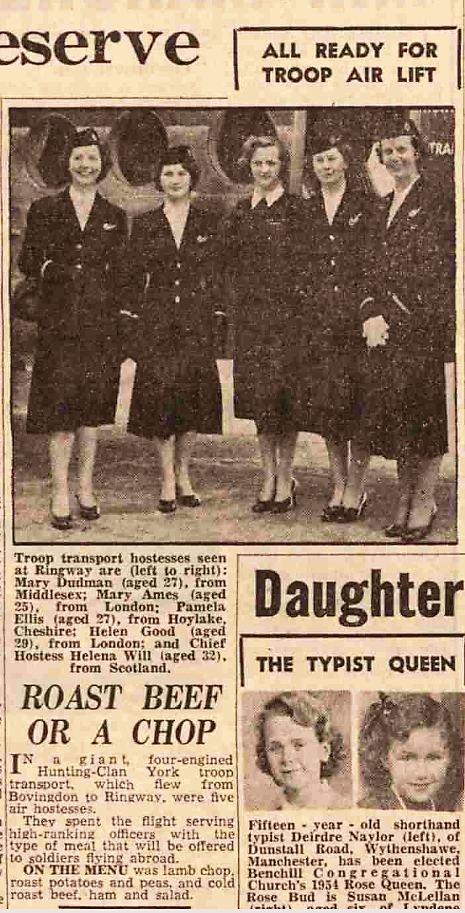
30 April 1954. Manchester Evening News. (BNA)
1954 now and Huntings are out to seduce The War Department and The Air Ministry with Women and Fine Food before the airline packs its bags at Bovingdon and moves off to London Airport.
1951 and already posted elsewhere on this thread. Food on an Eagle Aviation Trooping York. By Jackie Pritchard 2016.
' I flew on an Avro York G-AGNY this was in 1951 leaving Singapore and landing for over night stops in Ceylon, Bombay, Karachi, Iraq, Malta, and finally England. This was a bare bones flight, the plane had seating of all descriptions old car seats, coach seats, you name it, we boarded wearing only our tropical uniform but had the sense thank goodness to carry our great coats. The plane was exactly the same as if being used for cargo no heating and the fuselage was clearly visible rivets and all, we half froze to death the steward was the navigator, the food was in little brown cardboard boxes complete with dry curled up meat and not forgetting a small wooden knife and fork. I often think about that journey and wonder if there are many left who were on that flight with me.'
Last edited by OUAQUKGF Ops; 6th Aug 2023 at 18:17. Reason: Add Video Link
Loss of HP Halton G-AHDX 16 April 1950
Worldair Carriers Ltd, Bovingdon. Cargo Flight - Sector Amsterdam-Brindisi. Destination Tehran.

I think this was salvaged from the wreckage.
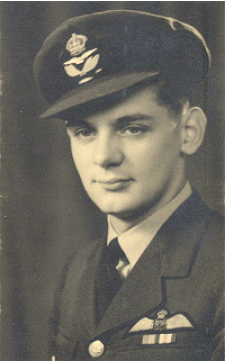
Captain Bryan Lathom-Smith 1924-1950.

Nottinghamshire Guardian 17 April 1950 (BNA)
An uncompromising, concise bit of nineteen-fifties reporting. Presenting a questionable eye-witness account together with, I think, a premature statement by the Swiss Authorities. Very distressing to read for those so recently bereaved.
THE FLIGHT
The aircraft was at Schiphol on 14 April 1950. It was loaded on 15 April with a cargo of approx 3900 kg of Philips Domestic Radios (Model BX485AV) the sort of thing you listened to 'Mrs Dale's Diary' on - or perhaps not ? The cargo 'Volumed Out' leaving 59 sets behind and the Halton comfortably below its MTOW.
16 April - 0210z Met Briefing. Poor weather forecast en-route to overhead Venice. Cloud base on the northern side of The Alps predicted at 600-1200 metres amsl. It seems the flight had already delayed for weather and I've read somewhere that the Met Officer suggested a further delay of a couple of hours but I'm not sure. He did recommend to the crew that they should operate the sector at an altitude of 5000 metres until approaching Venice.
0245z ATC Flight Plan Filed - received at among other stations Munich-Geneva and Zurich.
5,500ft IFR 2.10hr Amsterdam - Abeam Munich
15,500ft IFR 1.15hr Abeam Munich - Venice
7,500ft VFR 2.15hr Venice- Brindisi
Fuel Endurance 7hrs.15min.
0300z Start Up. 0315z Airborne.
0422z Q coded transmission from G-AHDX to Amsterdam giving "Position at 0415z 75km west of Wiesbaden"
0449z Q coded transmission from G-AHDX to Orly "En-route to Brindisi ETA 0855 At 0415z we were approx 100km west of Wiesbaden. Our altitude 1650m amsl"
This also noted by Auxerre, Strasbourg and Nancy Radio stations.
These are thought to be the only Radio transmissions made during the flight. At 0528z the Halton, possibly climbing slightly, flew into the Yurtenfluh on the north face of Mt Hohgant, south-east of Bern and disintegrated. Impact was at approx 1700 m (5,577ft). The weather was foggy, a cloudbase of 1000m amsl in rain and wet snow. The impact triggered an avalanche carrying wreckage 500 metres down to Alp Yurtentiepe where it lay covered in snow in a strip 1.2km x 200m. The bodies of 4 crew members and the Company's Brindisi Manager were efficiently recovered and taken to Bern. Investigators from the Swiss Federal Aviation Office were quickly on the scene and I think on that same day they recovered a damaged Navigation Chart which indicated that the Halton was approx 250km west of its flight planned route.
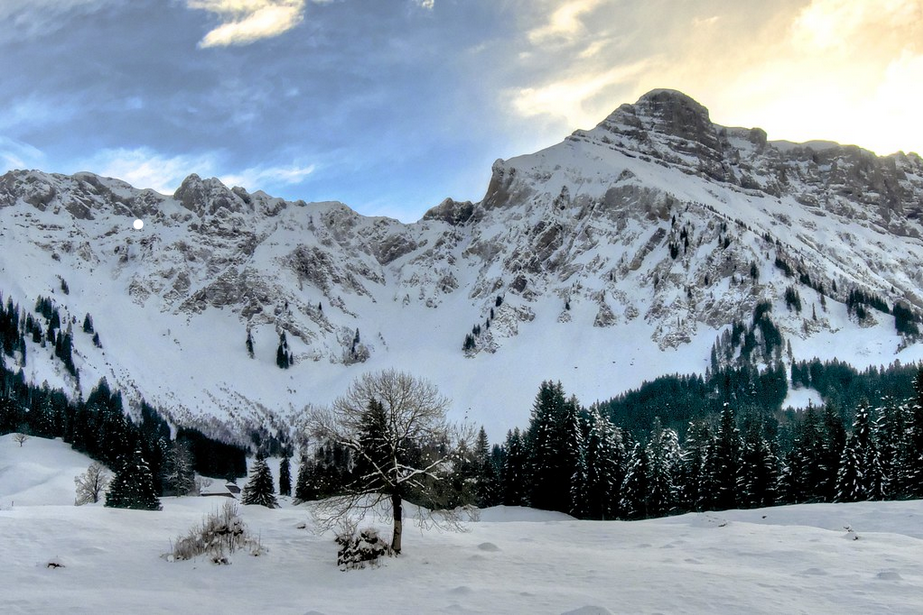
Point of impact. The Avalanche travelled down the adjacent slope to the left.
A Police appeal for witnesses resulted in reports from as far away as 60km to the north establishing the direction of flight south-wards towards Mt Hohgant. Rarely glimpsed through low cloud the aircraft was heard cruising steadily low. Because of Fog the crash was said not to have been seen but that the impact was widely heard as was the resultant avalanche. A witness mentioned hearing the engines being 'Throttled' just before impact.
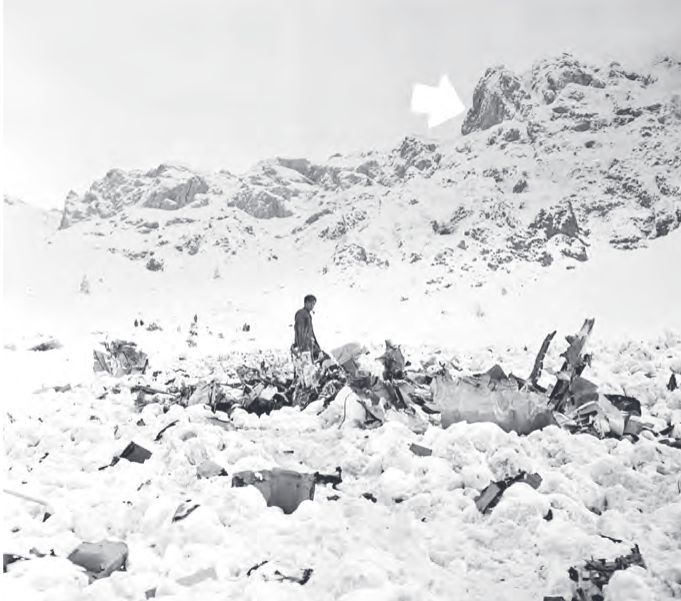
Photo: Walter Nydegger/Roger Cornioley.
https://www.britishpathe.com/asset/70429/
Although it was a three hour climb to the crash site sightseers and souvenir hunters turned up. Despite a Cordon being in place and with only limited policing being available (initially the Village Bobby from Schangnau) pilfering of wreckage, documents and radio parts occurred, the latter being very popular. Several prosecutions resulted.
Further recovery operations were not possible until the snows melted. One crew member was still missing.

Photo Chris Latham-Smith with thanks.
The Crew's Funeral at the Bremgarten Cemetery Bern on 19 April 1950.
On the 13 May 1950 the body of the Radio Operator Keith Allum was recovered and subsequently buried in the Churchyard at Schangnau.
25 May - Aerial Survey of site. 30th May - Scene inspected, documents recovered which proved valuable to investigators. Human remains buried on the spot.
3 -4 June Thorough search conducted with supervised team of 16 Scout Rovers looking for Ship's Papers and sorting wreckage. Debris in a niche in the rock 50 metres above impact point included parts of Philips radios , a rudder bar and a trim wheel. Debris at the foot of the cliff face and just below included the remains of a magnetic compass and a damaged aircraft radio. There had been a small engine fire on impact. No indications were found that the aircraft or its engines were defective at the time of the accident.
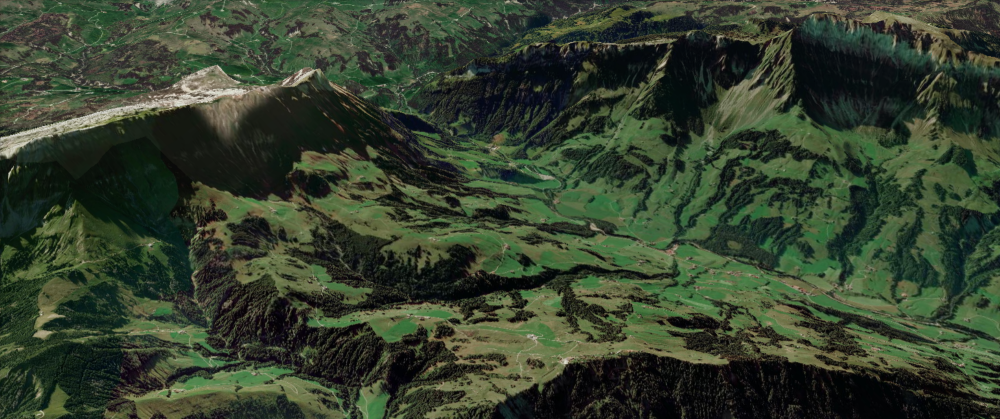
WEATHER
The Met Folder was salvaged but was very badly damaged. The data I've reproduced here was produced by The Swiss Aviation Weather Service mainly after the accident and I acknowledge the use of their images and data.
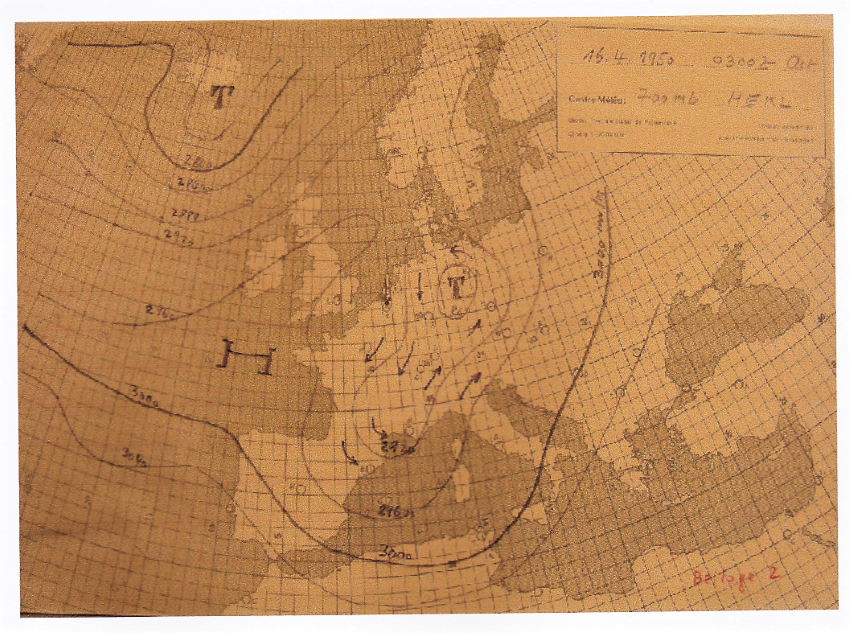
The flight had operated from Schiphol almost entirely in heavy layered cloud. The Swiss Aviation Weather Office calculated that isolated cloud breaks might have allowed ground visibility for about 10% of the route. Very much the whole of the Swiss Alps were covered with layered cloud and emerging Cumulus. A KLM Constellation (PH-TDC) northbound over the alps near Lucerne at 0700z that morning reported a solid ceiling of cloud with a strong swelling surface and tops at about 3000m amsl.
Forecast Winds 0300z-0600z 16 April 1950.
HOLLAND --SAAR- --MITTLELLAND--SALZBURG
1000m N10--NNE5----- NNW15----------- SW5
2000m N10--N20 -------W10---------------WSW5
3000m N20--N25------- NW5--------------SW10
4000m NE40-NNE45-- SW47----------- SW50
ICING
As a rank amateur I think that the Captain's decision to fly from Schiphol to Abeam Munich at 5,500ft rather than at 5000m as suggested by the Met Officer was quite understandable. By flying at 5,500ft he would hope to minimise icing, conserve oxygen and mitigate the effects of the cold. These factors were acknowledged by the investigators. The Captain was an experienced Halifax pilot who had flown in The Berlin Airlift. During the Airlift the Halifax, having no wing deicers had often encountered problems, particularly at night and in winter when attempting to operate at the stipulated altitude of 6000ft. This resulted in delayed or aborted missions. When BOAC initially took delivery of their Haltons in 1946 the fleet had to be grounded after a short time in service and returned to the manufacturer for modification due to inadequate wing deicing. G-AHDX would have been modified accordingly.
Forecast Icing Index 16 April 1950
Holland 0c 1200m
Switzerland 0c 1000m
-10c 2600m
-20c 6000m

Photo:Chris Latham-Smith.
ATC postwar Western Germany and Radio Silence.
British Sector: RAF Bad-Eilsen: FIR with ATCC providing FIS only.
French Sector: Eastern FIR controlled by FIC Strasbourg.
American Sector. USAF Frankfurt and Munich Area Control Centres and FIRS.
Civil Flights within Germany were only conducted by aircraft of the Occupying Powers. Routes to and through Germany were very few. Cornioley (2012) mentions that the Captain had forgotten to obtain German overflight permission. He doesn't enlarge on the matter. The relevant authorities would have been aware however when the ATC Flight Plan was filed.
The investigators noted that the last transmission heard from the aircraft was at 0449z. Here I quote roughly from an official document: (I am by this time, lost in translation). 'The aircraft did not work with the Swiss radio surveillance authorities nor was anything heard from it. The assumption is that after the 0449z report there was no radio communication with ATC since the aircraft assumed it was in the French occupied zone of Germany where there is an ATC no-man's-land in which no ATC checks are carried out. Whether the aircraft was receiving with its radios without transmitting could not be determined from The Radio Officer's scanty notes recovered from the wreckage. There is a presumption that a few minutes before the accident a bearing was taken on the 'UE' radio beacon near Bern. Since no radio traffic was observed during the second half of the flight it can be assumed that perhaps the radio system was unusable; then the onward flight would definitely have to have taken place at a higher altitude or it can be assumed that everything on board is in order and therefore no reports were given.'
The tuning box of an aircraft radio was recovered. The setting scales were still recognizable. This damaged component could not be fully identified. Photographs and sketches were sent to England for further analysis.
THE WIDER PICTURE
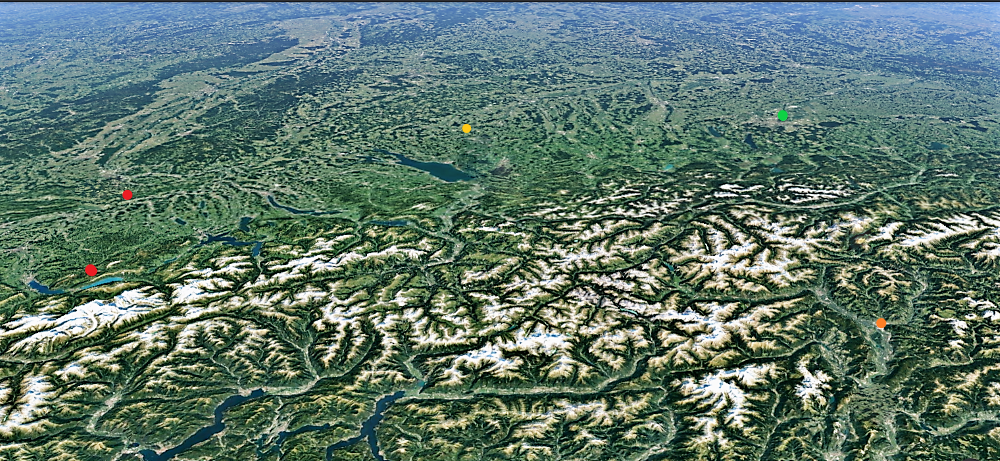
Looking NNW.
TOP RED: 0515z near Balsthal where first reports came of aircraft heard in the clouds. Approx 375 S Miles from Amsterdam.
BOTTOM RED: 0528z Impact Point.
YELLOW: Planned to be overhead at 0525z point 'Abeam Munich' 351 S Miles from Amsterdam and 33 S Miles N/W of Menningen. Navigator's chart marked 0515z at Menningen.
GREEN: Munich.
BROWN: Bolzano Italy. Waypoint crossing The Brenner Pass.

The Navigator's damaged chart salvaged from the wreckage on the day of the crash Photo: Swiss Federal Aviation Office. The coloured lines (difficult to distinguish) are those of the investigators. The Navigator's pencilled times are best seen using a magnifying glass !
CONCLUSION
I have not seen the Accident Report and have worked off Official Documents prepared in connection with the accident.
The investigators cited extremely poor weather, insufficient safety margins and poor navigational preparations as being the cause of the accident. They suspected from looking at the Navigator's salvaged chart that a bearing had been taken shortly before impact off the Uettligen Beacon near Bern at a range of 20 miles. This whilst trying to establish their position 'Abeam Munich'. The latest time written on the chart appears to be 0523z. The investigators were critical of the crew for not initiating an immediate climb to 15,500 ft when doubts about their position must have first been raised in the Navigator's mind.
To put it simply the Navigator had from the very start anticipated strong south-westerly winds instead of northerly winds on their track of 144 Degrees and maintained this assumption throughout the flight. The investigators noted that some of the cargo had been loaded in the nose compartment and possibly in the crew compartment too. The radio speakers contained a strong magnet. Tests were conducted for compass error but no firm conclusions were reached. Chris Latham-Smith added that if there had been such a problem his Father, who did everything by the book, would have noticed a compass problem on start up at Schiphol. The investigators also mentioned that 'The Twilight Effect' (Dawn) may also have caused problems while the crew were trying to establish their position.
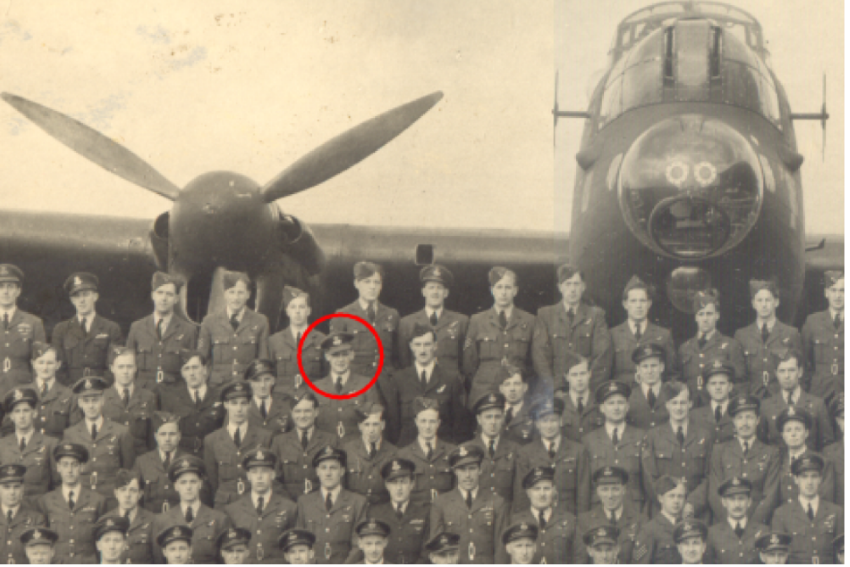
Photo: Chris Latham-Smith.
Bryan Lathom-Smith had flown many missions as a Pathfinder Pilot with 7 Squadron Royal Air Force.

Photo: Chris Latham-Smith.
THE CREW
Captain: Bryan Lathom-Smith 26 years old.
Navigator: Charles Henry Bowker 20 years old.
Radio Operator: Keith Allum 18 years old.
Flight Engineer: David Stanforth 25 years old.
K.S. Wright: Company Manager and acting Steward.
Arturo di Giulia. Passenger - Company Manager Brindisi.

The Church at Schangnau.
I would like to thank Chris Latham-Smith for his assistance, images and enthusiasm. He lost his Dad when he was 9 months old but had a happy childhood and now aged 73 is alive and kicking, living in France. I would also like to thank Hans Peter Tschanz in Switzerland without whose generous help this would not have been written. Further Reading: 'Zerschellt im Hochgebirge' by Roger Cornioley. Bern 2012. Can be read on the Internet in German.

I think this was salvaged from the wreckage.

Captain Bryan Lathom-Smith 1924-1950.

Nottinghamshire Guardian 17 April 1950 (BNA)
An uncompromising, concise bit of nineteen-fifties reporting. Presenting a questionable eye-witness account together with, I think, a premature statement by the Swiss Authorities. Very distressing to read for those so recently bereaved.
THE FLIGHT
The aircraft was at Schiphol on 14 April 1950. It was loaded on 15 April with a cargo of approx 3900 kg of Philips Domestic Radios (Model BX485AV) the sort of thing you listened to 'Mrs Dale's Diary' on - or perhaps not ? The cargo 'Volumed Out' leaving 59 sets behind and the Halton comfortably below its MTOW.
16 April - 0210z Met Briefing. Poor weather forecast en-route to overhead Venice. Cloud base on the northern side of The Alps predicted at 600-1200 metres amsl. It seems the flight had already delayed for weather and I've read somewhere that the Met Officer suggested a further delay of a couple of hours but I'm not sure. He did recommend to the crew that they should operate the sector at an altitude of 5000 metres until approaching Venice.
0245z ATC Flight Plan Filed - received at among other stations Munich-Geneva and Zurich.
5,500ft IFR 2.10hr Amsterdam - Abeam Munich
15,500ft IFR 1.15hr Abeam Munich - Venice
7,500ft VFR 2.15hr Venice- Brindisi
Fuel Endurance 7hrs.15min.
0300z Start Up. 0315z Airborne.
0422z Q coded transmission from G-AHDX to Amsterdam giving "Position at 0415z 75km west of Wiesbaden"
0449z Q coded transmission from G-AHDX to Orly "En-route to Brindisi ETA 0855 At 0415z we were approx 100km west of Wiesbaden. Our altitude 1650m amsl"
This also noted by Auxerre, Strasbourg and Nancy Radio stations.
These are thought to be the only Radio transmissions made during the flight. At 0528z the Halton, possibly climbing slightly, flew into the Yurtenfluh on the north face of Mt Hohgant, south-east of Bern and disintegrated. Impact was at approx 1700 m (5,577ft). The weather was foggy, a cloudbase of 1000m amsl in rain and wet snow. The impact triggered an avalanche carrying wreckage 500 metres down to Alp Yurtentiepe where it lay covered in snow in a strip 1.2km x 200m. The bodies of 4 crew members and the Company's Brindisi Manager were efficiently recovered and taken to Bern. Investigators from the Swiss Federal Aviation Office were quickly on the scene and I think on that same day they recovered a damaged Navigation Chart which indicated that the Halton was approx 250km west of its flight planned route.

Point of impact. The Avalanche travelled down the adjacent slope to the left.
A Police appeal for witnesses resulted in reports from as far away as 60km to the north establishing the direction of flight south-wards towards Mt Hohgant. Rarely glimpsed through low cloud the aircraft was heard cruising steadily low. Because of Fog the crash was said not to have been seen but that the impact was widely heard as was the resultant avalanche. A witness mentioned hearing the engines being 'Throttled' just before impact.

Photo: Walter Nydegger/Roger Cornioley.
https://www.britishpathe.com/asset/70429/
Although it was a three hour climb to the crash site sightseers and souvenir hunters turned up. Despite a Cordon being in place and with only limited policing being available (initially the Village Bobby from Schangnau) pilfering of wreckage, documents and radio parts occurred, the latter being very popular. Several prosecutions resulted.
Further recovery operations were not possible until the snows melted. One crew member was still missing.

Photo Chris Latham-Smith with thanks.
The Crew's Funeral at the Bremgarten Cemetery Bern on 19 April 1950.
On the 13 May 1950 the body of the Radio Operator Keith Allum was recovered and subsequently buried in the Churchyard at Schangnau.
25 May - Aerial Survey of site. 30th May - Scene inspected, documents recovered which proved valuable to investigators. Human remains buried on the spot.
3 -4 June Thorough search conducted with supervised team of 16 Scout Rovers looking for Ship's Papers and sorting wreckage. Debris in a niche in the rock 50 metres above impact point included parts of Philips radios , a rudder bar and a trim wheel. Debris at the foot of the cliff face and just below included the remains of a magnetic compass and a damaged aircraft radio. There had been a small engine fire on impact. No indications were found that the aircraft or its engines were defective at the time of the accident.

WEATHER
The Met Folder was salvaged but was very badly damaged. The data I've reproduced here was produced by The Swiss Aviation Weather Service mainly after the accident and I acknowledge the use of their images and data.

The flight had operated from Schiphol almost entirely in heavy layered cloud. The Swiss Aviation Weather Office calculated that isolated cloud breaks might have allowed ground visibility for about 10% of the route. Very much the whole of the Swiss Alps were covered with layered cloud and emerging Cumulus. A KLM Constellation (PH-TDC) northbound over the alps near Lucerne at 0700z that morning reported a solid ceiling of cloud with a strong swelling surface and tops at about 3000m amsl.
Forecast Winds 0300z-0600z 16 April 1950.
HOLLAND --SAAR- --MITTLELLAND--SALZBURG
1000m N10--NNE5----- NNW15----------- SW5
2000m N10--N20 -------W10---------------WSW5
3000m N20--N25------- NW5--------------SW10
4000m NE40-NNE45-- SW47----------- SW50
ICING
As a rank amateur I think that the Captain's decision to fly from Schiphol to Abeam Munich at 5,500ft rather than at 5000m as suggested by the Met Officer was quite understandable. By flying at 5,500ft he would hope to minimise icing, conserve oxygen and mitigate the effects of the cold. These factors were acknowledged by the investigators. The Captain was an experienced Halifax pilot who had flown in The Berlin Airlift. During the Airlift the Halifax, having no wing deicers had often encountered problems, particularly at night and in winter when attempting to operate at the stipulated altitude of 6000ft. This resulted in delayed or aborted missions. When BOAC initially took delivery of their Haltons in 1946 the fleet had to be grounded after a short time in service and returned to the manufacturer for modification due to inadequate wing deicing. G-AHDX would have been modified accordingly.
Forecast Icing Index 16 April 1950
Holland 0c 1200m
Switzerland 0c 1000m
-10c 2600m
-20c 6000m

Photo:Chris Latham-Smith.
ATC postwar Western Germany and Radio Silence.
British Sector: RAF Bad-Eilsen: FIR with ATCC providing FIS only.
French Sector: Eastern FIR controlled by FIC Strasbourg.
American Sector. USAF Frankfurt and Munich Area Control Centres and FIRS.
Civil Flights within Germany were only conducted by aircraft of the Occupying Powers. Routes to and through Germany were very few. Cornioley (2012) mentions that the Captain had forgotten to obtain German overflight permission. He doesn't enlarge on the matter. The relevant authorities would have been aware however when the ATC Flight Plan was filed.
The investigators noted that the last transmission heard from the aircraft was at 0449z. Here I quote roughly from an official document: (I am by this time, lost in translation). 'The aircraft did not work with the Swiss radio surveillance authorities nor was anything heard from it. The assumption is that after the 0449z report there was no radio communication with ATC since the aircraft assumed it was in the French occupied zone of Germany where there is an ATC no-man's-land in which no ATC checks are carried out. Whether the aircraft was receiving with its radios without transmitting could not be determined from The Radio Officer's scanty notes recovered from the wreckage. There is a presumption that a few minutes before the accident a bearing was taken on the 'UE' radio beacon near Bern. Since no radio traffic was observed during the second half of the flight it can be assumed that perhaps the radio system was unusable; then the onward flight would definitely have to have taken place at a higher altitude or it can be assumed that everything on board is in order and therefore no reports were given.'
The tuning box of an aircraft radio was recovered. The setting scales were still recognizable. This damaged component could not be fully identified. Photographs and sketches were sent to England for further analysis.
THE WIDER PICTURE

Looking NNW.
TOP RED: 0515z near Balsthal where first reports came of aircraft heard in the clouds. Approx 375 S Miles from Amsterdam.
BOTTOM RED: 0528z Impact Point.
YELLOW: Planned to be overhead at 0525z point 'Abeam Munich' 351 S Miles from Amsterdam and 33 S Miles N/W of Menningen. Navigator's chart marked 0515z at Menningen.
GREEN: Munich.
BROWN: Bolzano Italy. Waypoint crossing The Brenner Pass.

The Navigator's damaged chart salvaged from the wreckage on the day of the crash Photo: Swiss Federal Aviation Office. The coloured lines (difficult to distinguish) are those of the investigators. The Navigator's pencilled times are best seen using a magnifying glass !
CONCLUSION
I have not seen the Accident Report and have worked off Official Documents prepared in connection with the accident.
The investigators cited extremely poor weather, insufficient safety margins and poor navigational preparations as being the cause of the accident. They suspected from looking at the Navigator's salvaged chart that a bearing had been taken shortly before impact off the Uettligen Beacon near Bern at a range of 20 miles. This whilst trying to establish their position 'Abeam Munich'. The latest time written on the chart appears to be 0523z. The investigators were critical of the crew for not initiating an immediate climb to 15,500 ft when doubts about their position must have first been raised in the Navigator's mind.
To put it simply the Navigator had from the very start anticipated strong south-westerly winds instead of northerly winds on their track of 144 Degrees and maintained this assumption throughout the flight. The investigators noted that some of the cargo had been loaded in the nose compartment and possibly in the crew compartment too. The radio speakers contained a strong magnet. Tests were conducted for compass error but no firm conclusions were reached. Chris Latham-Smith added that if there had been such a problem his Father, who did everything by the book, would have noticed a compass problem on start up at Schiphol. The investigators also mentioned that 'The Twilight Effect' (Dawn) may also have caused problems while the crew were trying to establish their position.

Photo: Chris Latham-Smith.
Bryan Lathom-Smith had flown many missions as a Pathfinder Pilot with 7 Squadron Royal Air Force.

Photo: Chris Latham-Smith.
THE CREW
Captain: Bryan Lathom-Smith 26 years old.
Navigator: Charles Henry Bowker 20 years old.
Radio Operator: Keith Allum 18 years old.
Flight Engineer: David Stanforth 25 years old.
K.S. Wright: Company Manager and acting Steward.
Arturo di Giulia. Passenger - Company Manager Brindisi.

The Church at Schangnau.
I would like to thank Chris Latham-Smith for his assistance, images and enthusiasm. He lost his Dad when he was 9 months old but had a happy childhood and now aged 73 is alive and kicking, living in France. I would also like to thank Hans Peter Tschanz in Switzerland without whose generous help this would not have been written. Further Reading: 'Zerschellt im Hochgebirge' by Roger Cornioley. Bern 2012. Can be read on the Internet in German.
Last edited by OUAQUKGF Ops; 20th Jun 2023 at 23:17.
A few more post-war snippets.
The continuing dearth of new photographic images of aeroplanes at Bovingdon leads me to fall back on press cuttings and their flimsy links to Bovingdon and beyond.
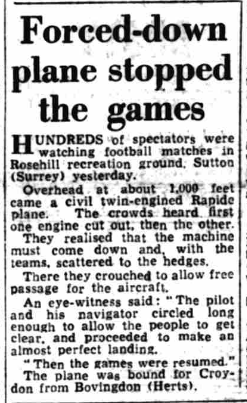
News Chronicle 28 March 1949 (BNA)

These Players unlike the Footballers were apparently unmoved by the aeroplane overhead...............
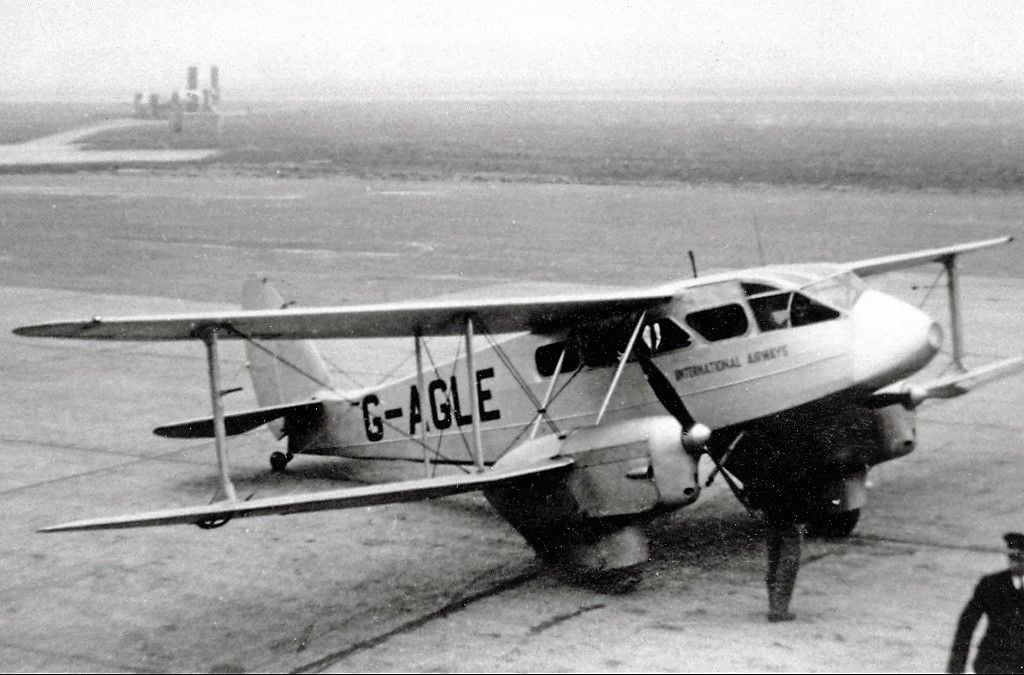
Photo: R.A. Scholefield with thanks.
On the occasion of its passengers attending The Grand National on March 26th 1949. The offending Article photographed at Liverpool the day before its tanks ran dry.
On March 27th the Dragon Rapide was on an empty positioning flight from Bovingdon to Croydon presumably having dropped its passengers off at Bovingdon the evening before. I'm not sure whether it sustained light damage on arrival at Rosehill but it remained there for several days before it was disassembled and taken the short distance to Croydon.

Image Credit Croydon Airport Website.
G-AGLE was one of three Dragon Rapides in the service of this company. Thomas Barclay also had an office in Bournemouth and Christopher Burton in whose name the Rapides were registered gives his address as The Sandacres Hotel (Built 1930s) Sandbanks, Poole. This incident led to an exchange of correspondence in 'The Aeroplane' (Vol 76). Unfortunately I've not been able to access it fully but it appears that the company certainly wanted to distance itself from what it called ' An Involuntary Landing' whilst continuing 'We would first wish to explain that the aircraft on this particular flight was on full hire to another charter company and we were not the responsible operating company.'

South Wales Echo 8 February 1950 (BNA)
Interestingly enough one pilot who enjoyed a short period of employment with Barclay's International Airways is Bernard Gardiner now aged a 101 years old and much feted these days as a World War 11 Typhoon Pilot. He retains his reputation as one of the pioneers of post-war Channel Islands Civil Aviation.
Jersey Airlines
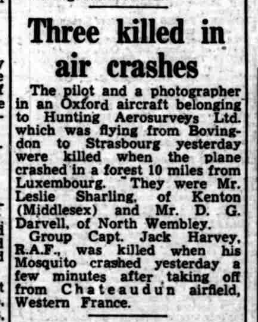
The Birmingham Gazette 18 July 1952 (BNA)
The aeroplane concerned was an Airspeed Oxford G-AIRZ. The flight originated from Elstree and presumably called at Bovingdon for outbound Customs clearance. It was flying to Strasbourg with the final destination of Klagenfurt where it was due to undertake a contract with the Austrian Authorities.

Photo: Barry Friend with thanks
Well, as usual I can't find an image of the subject aircraft but this picture of an Air Service Training Airspeed Oxford is rather fine.

A Memorial was dedicated on 30 June 1957. The pilot was Leslie Sharling and the Photographer was D.G. Darvell.

The accident occurred in southern Luxembourg a few kilometres west of the small town of Kayl. The land here is generally 300-400M amsl elevation. These hills are forested. The causes of the accident are unclear but the Oxford appears to have hit a hill. Contemporary reports mention the aeroplane falling almost vertically from the sky, hitting an oak tree and disintegrating. Estate workers nearby came quickly to the scene but unfortunately the crew were found to be dead. Another report has the Oxford diving into a field. It is reported that the wreckage was taken to a scrap yard which makes one wonder whether there had been a post impact fire or not ?

The memorial is by the N33. It is good to see in this recent image that it is tended.
On a more jolly note Hunting Aerosurveys were first based at Luton before moving to Elstree. Here is rather a splendid (leisurely for some) snap from Elstree.
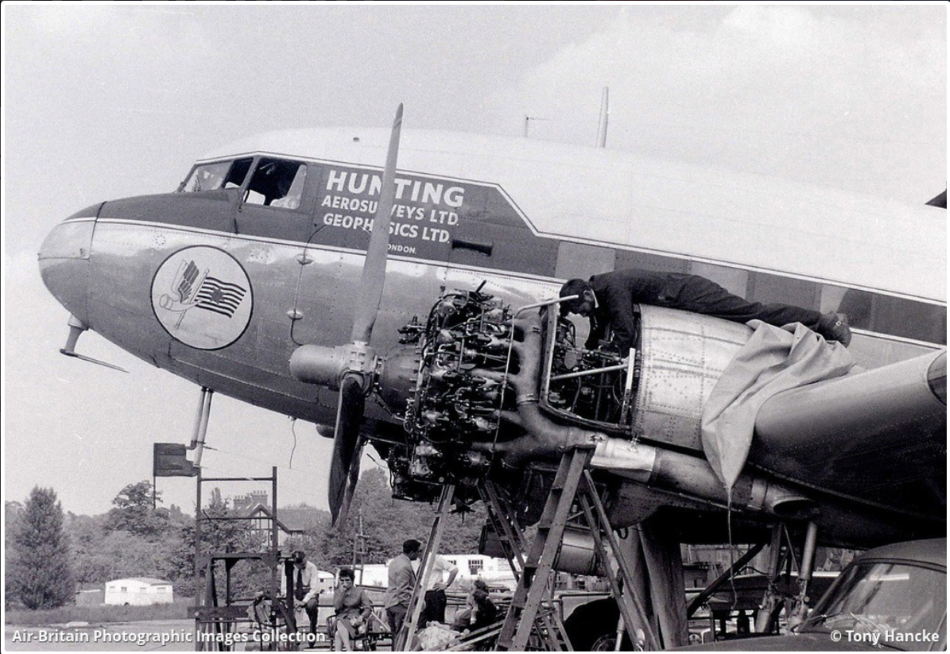
Photo Tony Hancke with thanks. DC3 G-AMVB Elstree 1958.
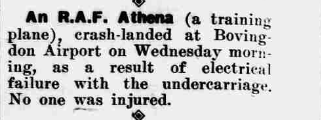
Bucks Examiner 11 June 1954 (BNA)
Avro Athena T2 VR574 of the Gunnery School, RAF Flying College, Manby Lincs. Written off at Bovingdon 9th June 1954.

Photo avionslegendaires.net
Prototype Athena T1 VM125 powered by Armstrong Siddeley Mamba. First flew 12 June 1948. Written off August 30 1949.
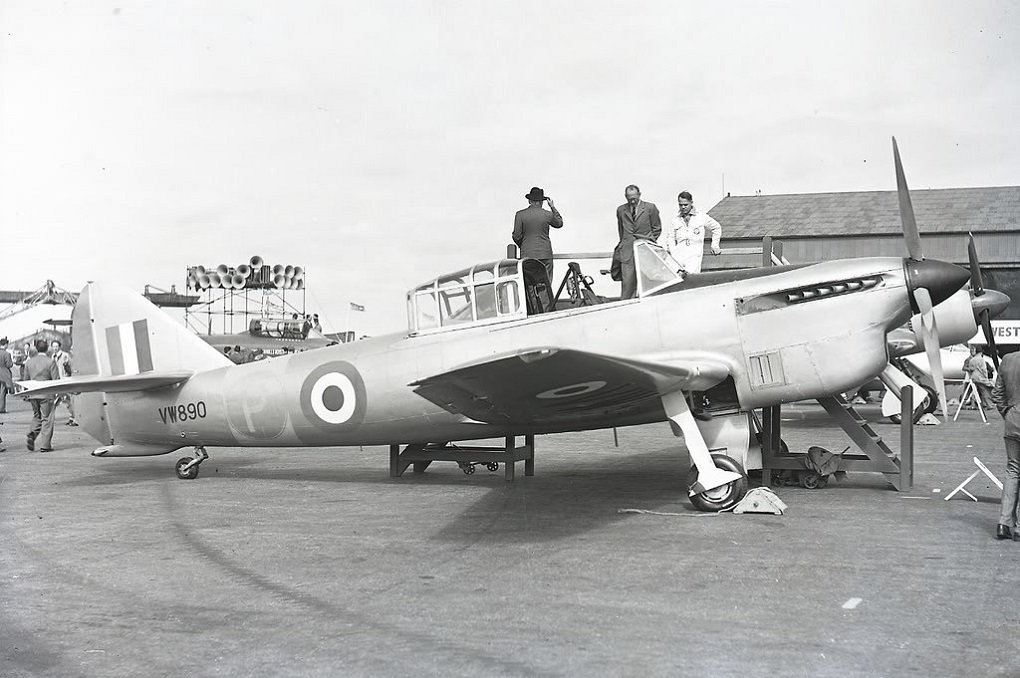
Photo avionslegendaires.net
Prototype Athena T2 VW890 powered by Rolls Royce Merlin. First flew 1 August 1948 and pictured here at Farnborough SBAC Show that year. Unfortunately the Athena was eclipsed by the Boulton Paul Balliol when it came to The Royal Air Force ordering an advanced piston training aircraft with just 22 Athenas T2s seeing service, all with the RAF Flying College at Manby.

News Chronicle 28 March 1949 (BNA)

These Players unlike the Footballers were apparently unmoved by the aeroplane overhead...............

Photo: R.A. Scholefield with thanks.
On the occasion of its passengers attending The Grand National on March 26th 1949. The offending Article photographed at Liverpool the day before its tanks ran dry.
On March 27th the Dragon Rapide was on an empty positioning flight from Bovingdon to Croydon presumably having dropped its passengers off at Bovingdon the evening before. I'm not sure whether it sustained light damage on arrival at Rosehill but it remained there for several days before it was disassembled and taken the short distance to Croydon.

Image Credit Croydon Airport Website.
G-AGLE was one of three Dragon Rapides in the service of this company. Thomas Barclay also had an office in Bournemouth and Christopher Burton in whose name the Rapides were registered gives his address as The Sandacres Hotel (Built 1930s) Sandbanks, Poole. This incident led to an exchange of correspondence in 'The Aeroplane' (Vol 76). Unfortunately I've not been able to access it fully but it appears that the company certainly wanted to distance itself from what it called ' An Involuntary Landing' whilst continuing 'We would first wish to explain that the aircraft on this particular flight was on full hire to another charter company and we were not the responsible operating company.'

South Wales Echo 8 February 1950 (BNA)
Interestingly enough one pilot who enjoyed a short period of employment with Barclay's International Airways is Bernard Gardiner now aged a 101 years old and much feted these days as a World War 11 Typhoon Pilot. He retains his reputation as one of the pioneers of post-war Channel Islands Civil Aviation.
Jersey Airlines

The Birmingham Gazette 18 July 1952 (BNA)
The aeroplane concerned was an Airspeed Oxford G-AIRZ. The flight originated from Elstree and presumably called at Bovingdon for outbound Customs clearance. It was flying to Strasbourg with the final destination of Klagenfurt where it was due to undertake a contract with the Austrian Authorities.

Photo: Barry Friend with thanks
Well, as usual I can't find an image of the subject aircraft but this picture of an Air Service Training Airspeed Oxford is rather fine.

A Memorial was dedicated on 30 June 1957. The pilot was Leslie Sharling and the Photographer was D.G. Darvell.

The accident occurred in southern Luxembourg a few kilometres west of the small town of Kayl. The land here is generally 300-400M amsl elevation. These hills are forested. The causes of the accident are unclear but the Oxford appears to have hit a hill. Contemporary reports mention the aeroplane falling almost vertically from the sky, hitting an oak tree and disintegrating. Estate workers nearby came quickly to the scene but unfortunately the crew were found to be dead. Another report has the Oxford diving into a field. It is reported that the wreckage was taken to a scrap yard which makes one wonder whether there had been a post impact fire or not ?

The memorial is by the N33. It is good to see in this recent image that it is tended.
On a more jolly note Hunting Aerosurveys were first based at Luton before moving to Elstree. Here is rather a splendid (leisurely for some) snap from Elstree.

Photo Tony Hancke with thanks. DC3 G-AMVB Elstree 1958.

Bucks Examiner 11 June 1954 (BNA)
Avro Athena T2 VR574 of the Gunnery School, RAF Flying College, Manby Lincs. Written off at Bovingdon 9th June 1954.

Photo avionslegendaires.net
Prototype Athena T1 VM125 powered by Armstrong Siddeley Mamba. First flew 12 June 1948. Written off August 30 1949.

Photo avionslegendaires.net
Prototype Athena T2 VW890 powered by Rolls Royce Merlin. First flew 1 August 1948 and pictured here at Farnborough SBAC Show that year. Unfortunately the Athena was eclipsed by the Boulton Paul Balliol when it came to The Royal Air Force ordering an advanced piston training aircraft with just 22 Athenas T2s seeing service, all with the RAF Flying College at Manby.
Last edited by OUAQUKGF Ops; 1st May 2023 at 10:50.
Blink and you'll miss Him

Coronation Day 1953 Image BBC


No it's not Bovingdon........

Sussex Daily News 18 July 1953
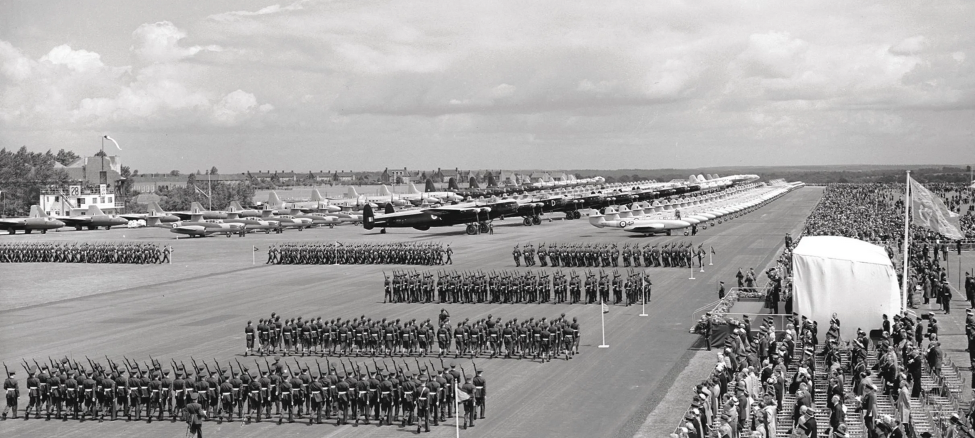
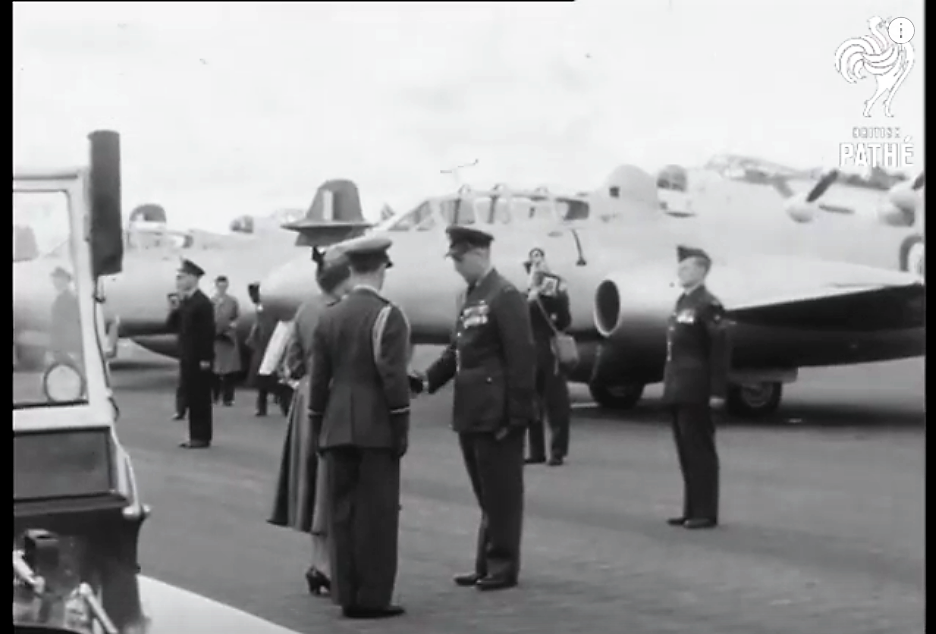
Might this be the elusive Squadron Leader ? He looks suitably be-medalled and mature for a chap with 16 years Service. Perhaps the uniform is not quite right - is that a shoulder tab ? Later - sorry my mistake. The above is Wing Commander Lindsay Royal Canadian Air Force (Sabres). Squadron Leader Chapman he is not........I've substituted the video for a fuller version.
I hope that Squadron Leader Chapman's parents didn't draw on their pensions too heavily to buy a TV for the big day.


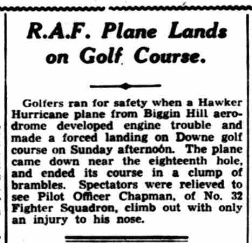
Bromley and West Kent Mercury 3 March 1939 (BNA)
Later Robert Chapman served with ' K Flt ' 112 Squadron' 16 May 1939 - 10 September 1940. Flying Gladiators based Port Sudan Region. Next information I can find about him is that he was Officer Commanding 41 Squadron 28 May -28 August 1944. Operating Spitfires providing Air Support for D-Day build up, D Day and after before being re-deployed solely on the destruction of V1s of which the Squadron claimed its last and 53rd on 28 August 1944.
Last edited by OUAQUKGF Ops; 7th May 2023 at 09:40. Reason: Correction and Expansion
There are people far better informed than me who can comment on this post. I think it was not an unknown thing to happen after the end of The War. According to the newspaper clipping he was a Squadron Leader in 1953 when he was O.C. the RAF contingent (Comms Squad ?) at Bovingdon.
Last edited by OUAQUKGF Ops; 9th May 2023 at 08:42.
Drifting Down Chubb Drive
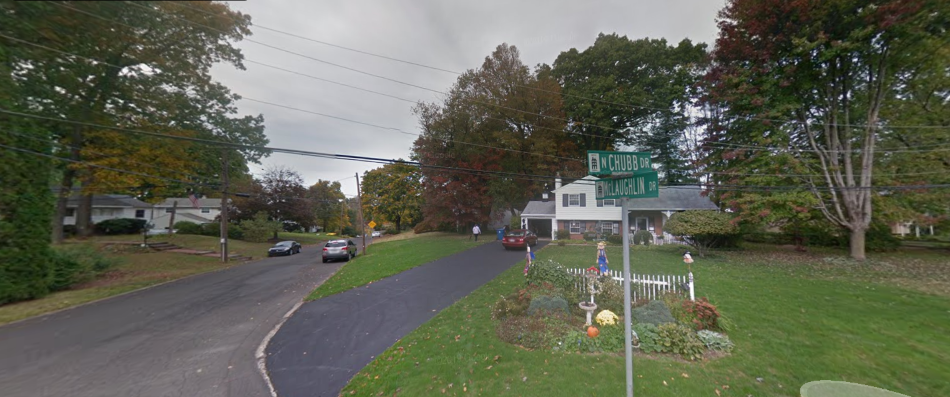
Doylestown, Pennsylvania.
LOSS OF A TEXAN

Photo Robert Astrella. North American AT-D6 Texan 7th PG Mount Farm, England

Knoxville Tennessee Local Paper June 1944
(No mention of this accident found in the British Press which at the time was preoccupied with post D Day Operations and the arrival of Flying Bombs in England).
On the 14th of June 1944 an AT-D6 Texan 41-34655 crashed near Ryton on Dunsmore, Warwickshire. The aeroplane, which was based with 'A Flight' 8th AF Headquarters Squadron Bovingdon, suffered a structural failure, loosing its port wing and tail assembly. The pilot First Lt Harry Wayland jumped without a parachute some 500 feet to his death while his passenger Lt Mary Chubb died in the wreckage. As far as I can tell the circumstances under which the flight took place are not clear. I have seen it mentioned that it might have been a pleasure flight which is a reasonable bit of speculation. Mary Chubb, thirty-one years old, was a Military Nurse based with the 181st Medical Dispensary (Aviation) at High Wycombe, some thirty minutes drive away from Bovingdon. I believe that she flew on medical evacuation flights and was described by a fellow nurse as being a very happy character.

Extracted from Chester County Hall of Heroes PA.
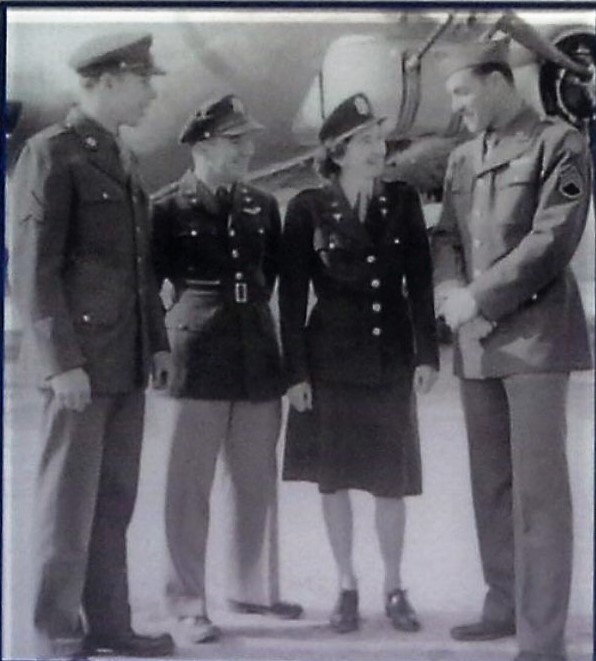
In England they met only once. Donald Chubb, recently arrived, next to his sister Mary.
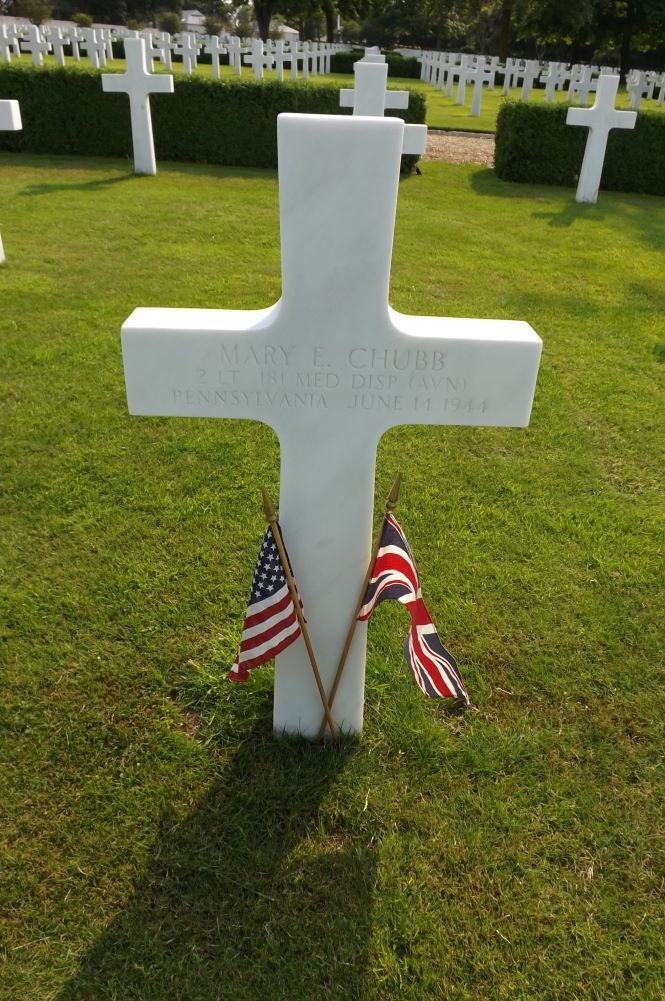
The American Cemetery, Cambridge.
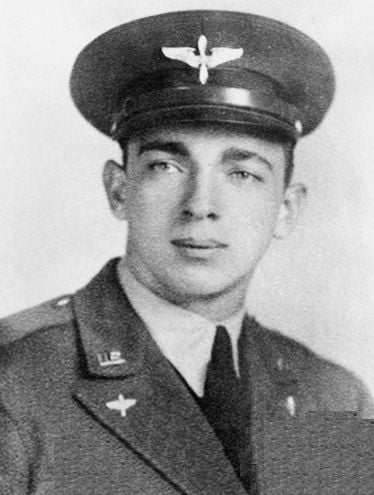
Harry Wayland. Photo: American Air Museum in Britain.
At the time of his death Harry Wayland was twenty-five years old, decorated, with 30 Missions completed as a B17 pilot with the 413th BS at Snetterton Heath, Norfolk. Having completed his Tour so to speak, he elected not to return to the USA but took an assignment to the 8th AF Headquarters Signals Section at Bovingdon. It is said that he was involved with the use of 'Radios in Combat' and that he had volunteered to fly missions where special radio equipment would be used. Letters home to his parents mentioned that he was working on a special project. This was very likely 'Project Aphrodite' (See Page 24 # 463 this thread). Harry Wayland is buried at Woodlawn Cemetery, Knoxville, Tennesee.
Donald Chubb and his Crew..........

Source 384th BG.Com.
This Missing Air Crew Report was prepared exactly seventy-nine years ago, today.
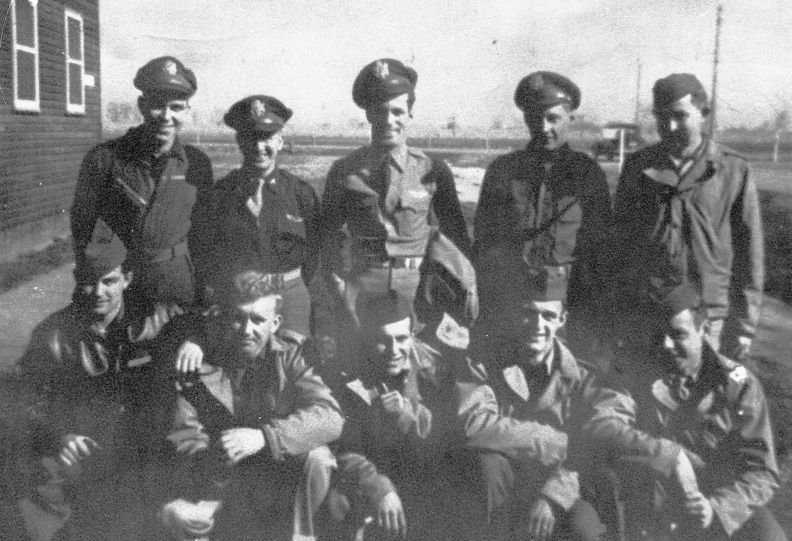
Source 384th BG.Com. James Wesley Brown and his Crew.
Newly arrived (April 1944) in England joining the 547th BS - 384BG at Grafton Underwood, Northamptonshire.
Unfortunately no names are given. I can with certainty identify Second Lt James Wesley Brown jnr Pilot (top left) and next to him twenty-two year old Second Lt Donald Vernon Chubb Co-Pilot. I suspect that next to Chubb is the Navigator, Second Lt Kenneth Myron Jones and next to him possibly the Bombadier, Second Lt Carl William Kuba but I cannot be sure. Other crew members were Staff Sgt Joseph John Kozar Radio Op/Gunner. Staff Sgt Merle Ernest Ingmire EO/Top Gunner. Staff Sgt James Augustine Hatton Ball Turret Gunner. Staff Sgt George Hallow Yeager jnr Tail Gunner. Staff Sgt Donald Edward Reis Flex Gunner and Staff Sgt Julius Eugene McClintick Flex Gunner.
Only Carl Kuba would survive the War and continue to serve in the USAF before dying in 1970 aged 53.
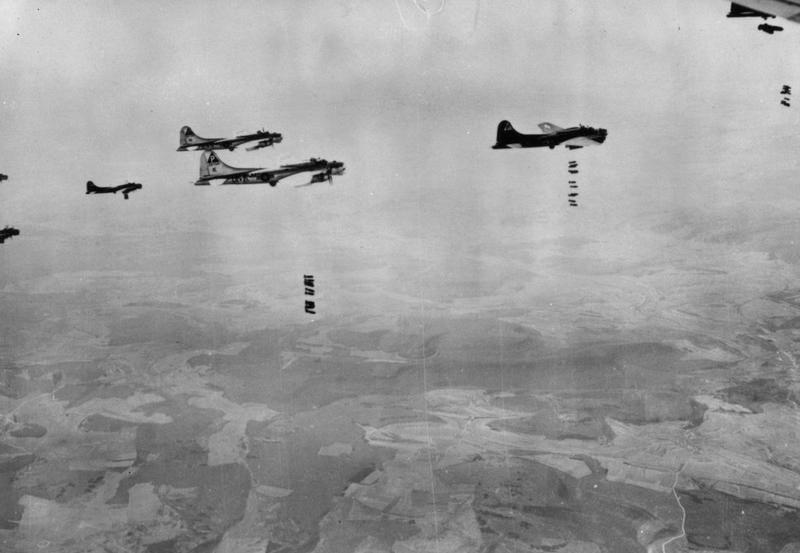
James Wesley Brown's ill-fated B17 42-97081 was lost on May 8th 1944. Seen here (nearest camera) on March 28th 1944 bombing Dijon-Longvic Airfield.
May 8th 1944 'Crossbow' Mission to V2 Bunker under construction at Sottevast near Cherbourg.
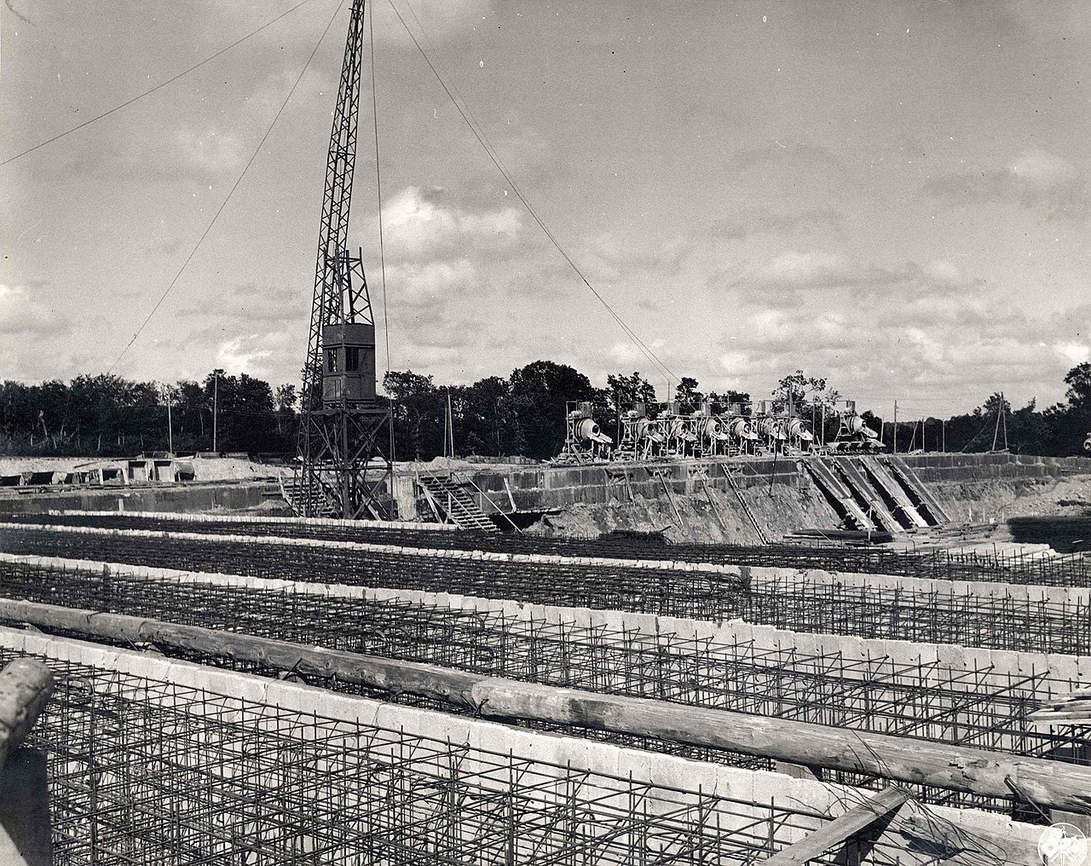
Source Wikipedia.
This was a return mission to Sottevast for James Wesley Brown's crew who only had in total two or three previous missions under their belt.
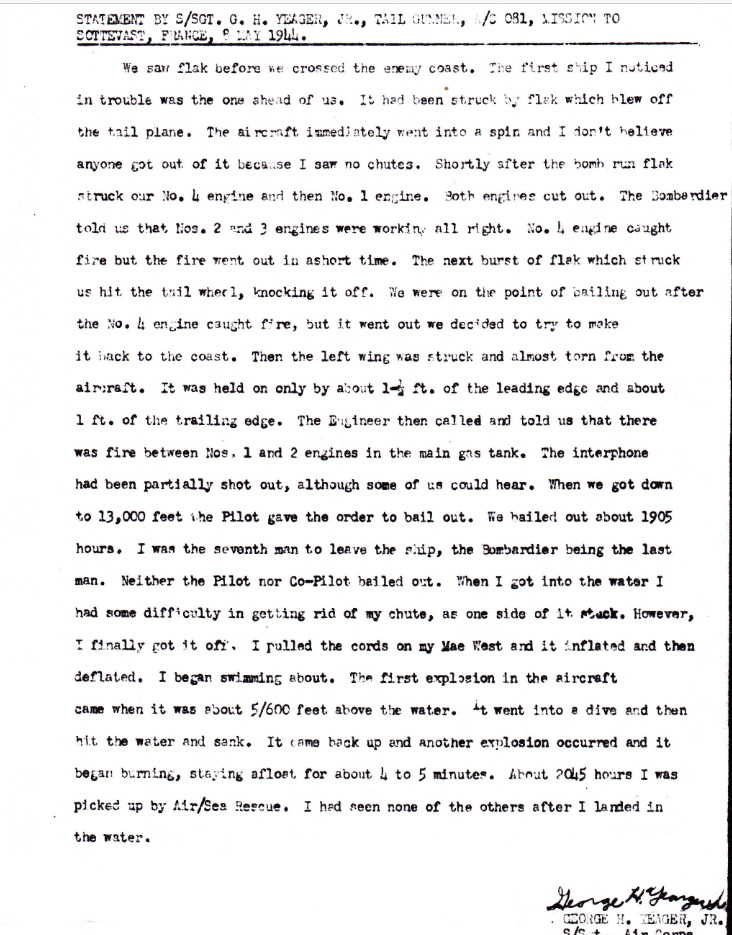
Source 384th BG.Com
Carl Kuba and George Yeager survived. Donald Reis succumbed to Hypothermia - he is buried at Oakland Cemetery, Sandusky Ohio. George Yeager continued on operations as a Tail Gunner and Togglier until flak removed the nose of his B17 "back to the Instrument Panel' near Munich on 16th July 1944. He was one of four crew members to die (remainder captured) and is buried at The Ardennes American Cemetery Belgium. James Wesley Brown jnr 's name is on The Wall of The Missing at the same Cemetery. The remainder of his crew with the exception of Donald Chubb are remembered on the Wall of The Missing at The Cambridge American Cemetery, England.
Donald Chubb's name is on The Wall of The Missing at the Normandy American Cemetery at Colville-sur- Mer, France.
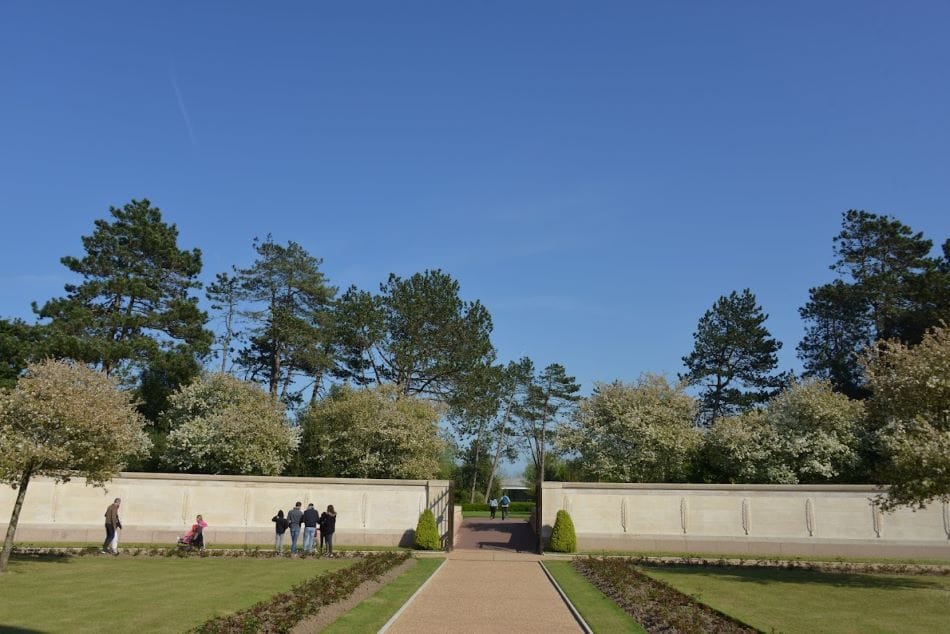
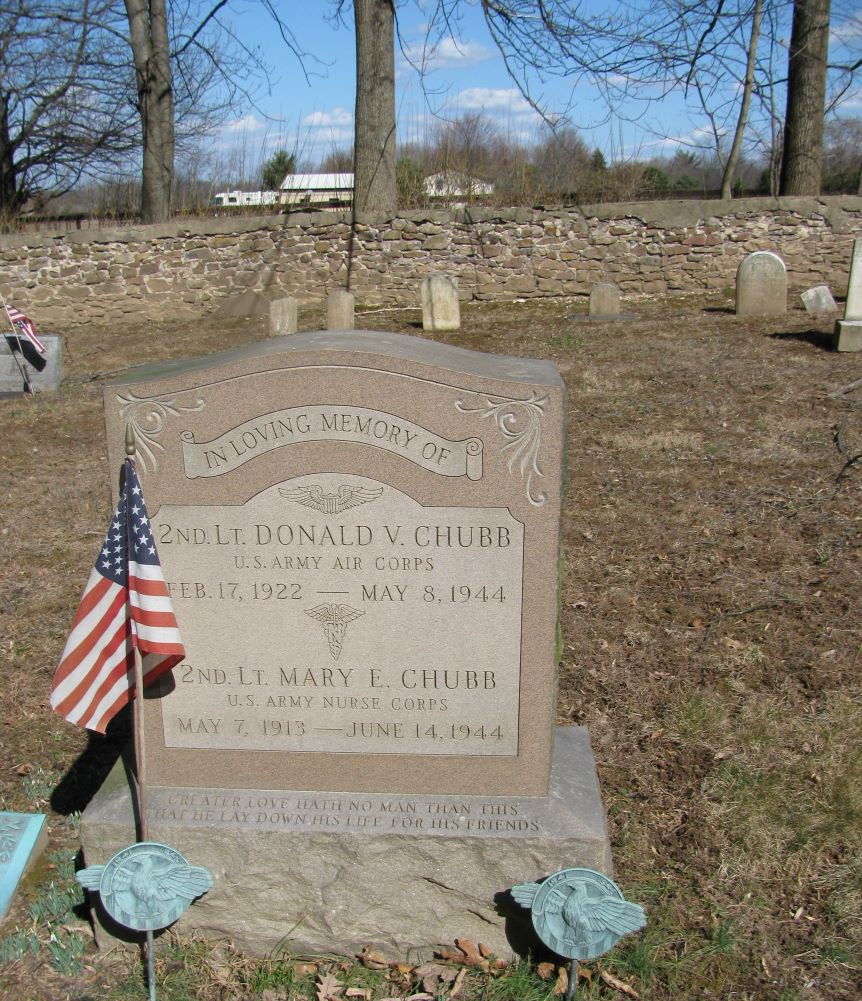
Fountainville Chapel Cemetery, Doylestown PA. Photo: Gail Kelly.
Last edited by OUAQUKGF Ops; 22nd May 2023 at 12:13. Reason: Add image B17 42-97081
Post Script
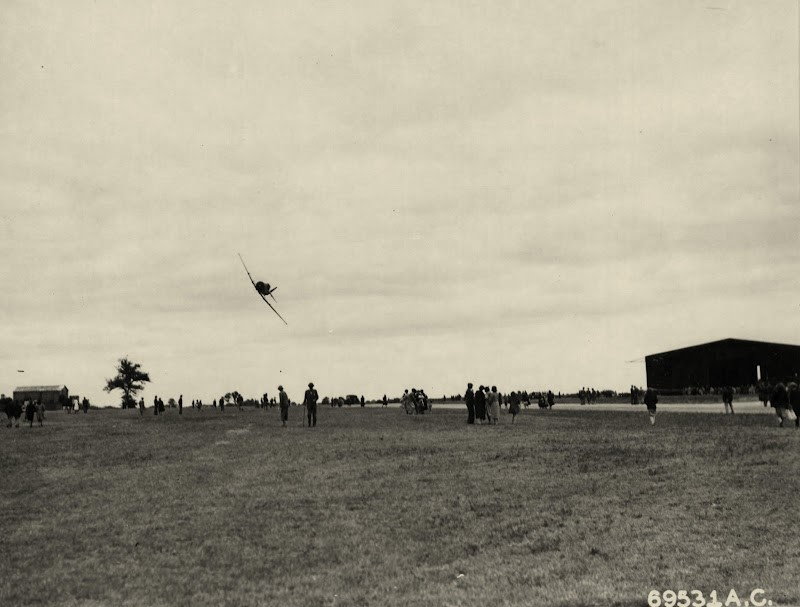
AT-6D Texan at unknown UK location.
'A Flight' 8th Air Force HQ Squadron at Bovingdon was I suppose the equivalent of a British Comms Squadron. During The War the following types were used by 'A Flight' at Bovingdon. Beechcraft Expeditor, Bell Aircobra, Cessna Bobcat, Curtiss Tomahawk, Douglas Boston, Douglas Havoc, Fairchild Argus, Lockheed Lightning, Martin Marauder, North American Texan and Republican Thunderbolt.
'A Flight' 8th Air Force HQ Squadron at Bovingdon was I suppose the equivalent of a British Comms Squadron. During The War the following types were used by 'A Flight' at Bovingdon. Beechcraft Expeditor, Bell Aircobra, Cessna Bobcat, Curtiss Tomahawk, Douglas Boston, Douglas Havoc, Fairchild Argus, Lockheed Lightning, Martin Marauder, North American Texan and Republican Thunderbolt.
I know John said the Cub was from Bovingdon but I wonder if it was actually from a temporary airstrip near Ashley Green (just west of Bovingdon) where there was a US Army Artillery Group billeted prior to the move south for D - Day. There is still a 'blister' hangar in a field there to this day and I can remember it from the early '50s.
A bit off the Bovingdon theme, but to add to all the Hunting Clan photos, I took this one at Entebbe when passing through from Kano to Nairobi as a Hastings second pilot in 1958
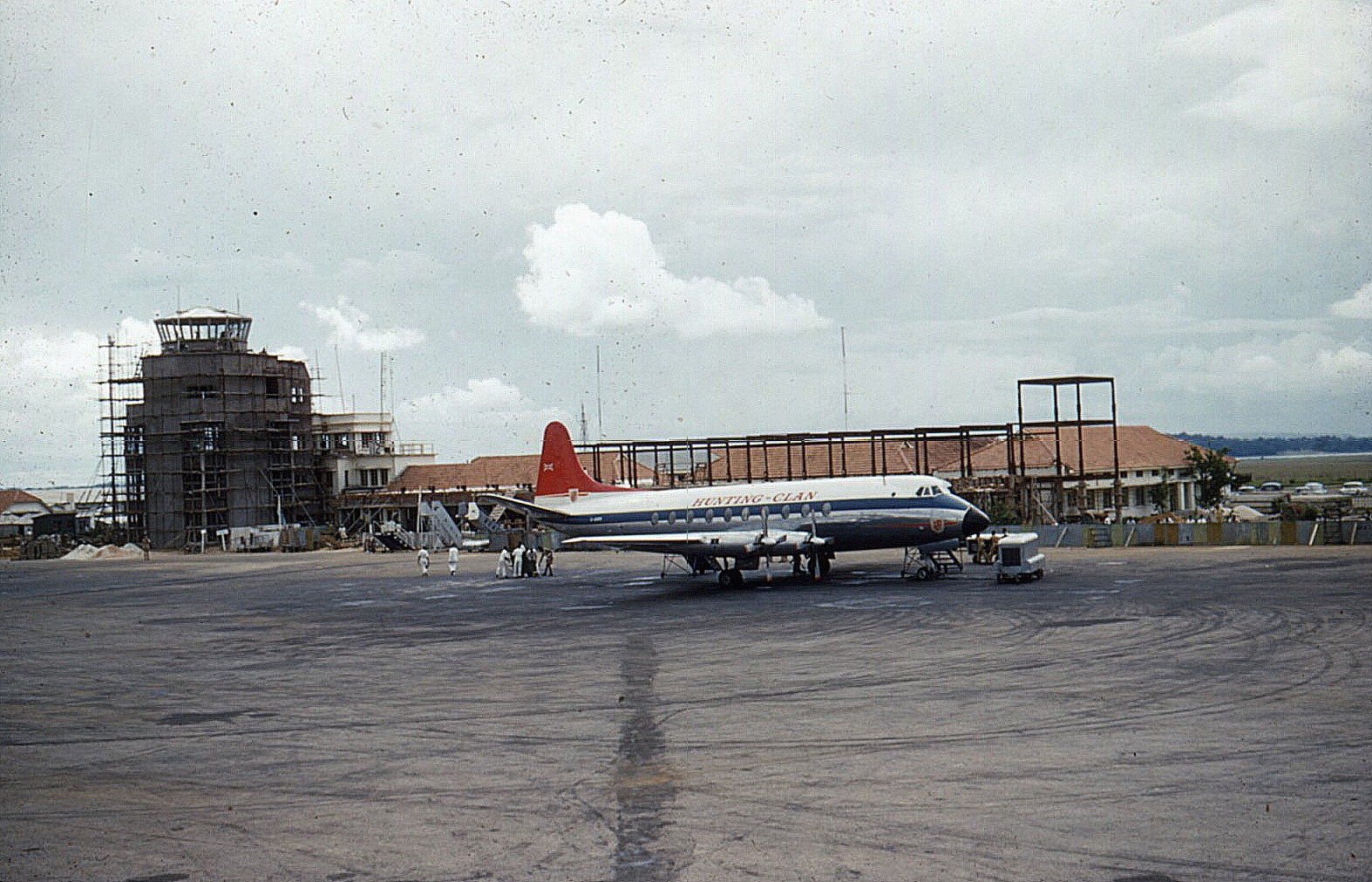

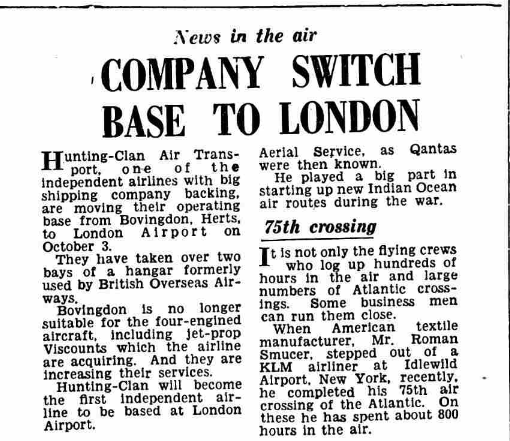
23 September 1954 Londonderry Sentinal.
No doubt London Airport a much more attractive proposition for every-body. Would a Viscount 701 with 40-50 Pax be able to cope with Bovingdon's 4800 feet Runway on a sector to Rome or Lisbon ?
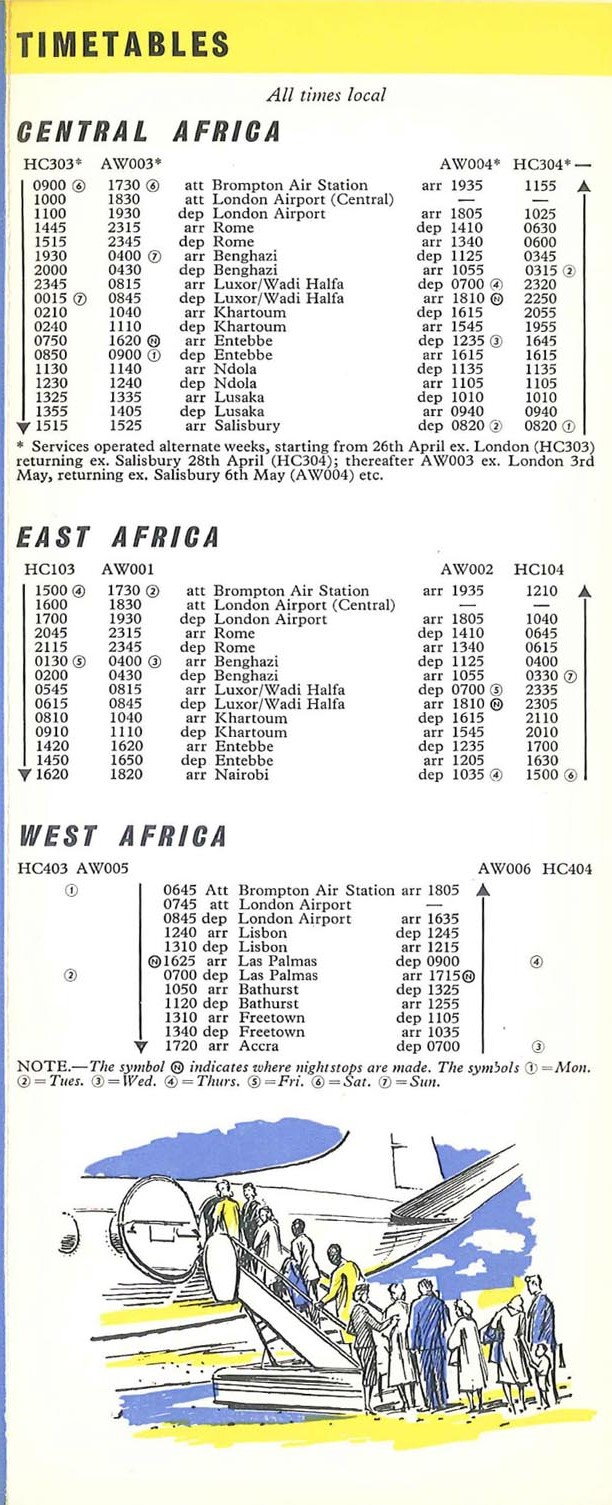
Hunting Clan Safari Air Services - Vickers Viscount - Summer 1958. (Bjorn Larsson Airline Timetable Images).
Last edited by OUAQUKGF Ops; 26th May 2023 at 13:32.
In 1954, they could have moved to Blackbushe; Stansted was just about to have major works starting and Gatwick was still waiting for its expansion to be started (at that time, the closure of Blackbushe and its reduction in runway length wasn't on the cards), Southend and Northolt both a bit short.
Freshly Plucked from The Ether ?
War-time image. Prior to late 1944 when the first hard-standing aprons were laid down. Photo: bovingdon-airfield.co.uk

Late 1940s-early 1950s ?
 H.P. Hermes HP Hermes G-ALDE at London Airport prior to Autumn 1954. Photo: J.M. Gradidge Collection with thanks.
H.P. Hermes HP Hermes G-ALDE at London Airport prior to Autumn 1954. Photo: J.M. Gradidge Collection with thanks.Bovingdon circa autumn 1954. G-ALDE parked on the dispersal adjacent to the Chesham Road with Whelpley Ash Farm barn in the background. Photo: bovingdon-airfield.co.uk
G-ALDE was purchased in September 1954 by Eric Rylands - Lancashire Aircraft Corporation - the first of the Hermes later purchased by Rylands in 1955 from BOAC for service with Skyways. I believe that they were first flown to Bovingdon for technical work/ config conversions/ initial crew training before entering service with Skyways at Stansted.

G-ALDE at Heathrow in January 1958.

At Newcastle May 28th 1961. Prior to entering service with Air Safaris in 1961 Eric Rylands had in 1959 converted this aircraft from a 68 pax to 78 pax config and added 3 windows aside fwd of the leading edge.
Air Safaris ceased operating in 1962 and G-ALDE was permanently withdrawn from use. Photograph and gen from the late Ian MacFarlane via Glen Auld with many thanks.
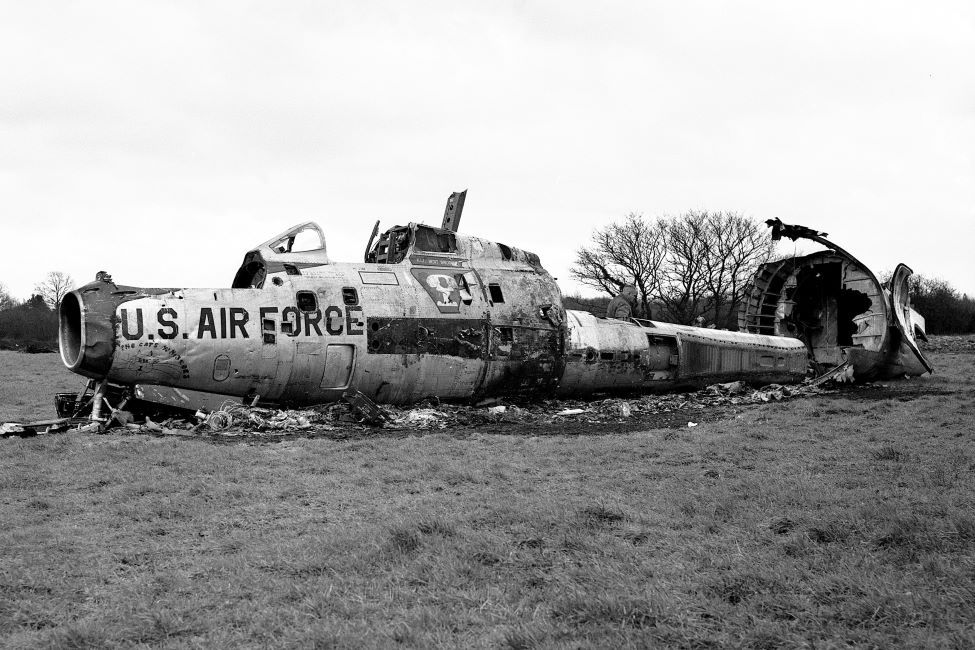
Thunderstreak on the fire dump at Bovingdon in 1958. Any ideas whose tail section is resting behind ?
B-50 48049 at Bovingdon 1950s. Photo the late Arthur Pearcy.
Bovingdon May 1957. Photo: Arthur Pearcy. Canberra of 10 Squadron RAF Scampton. Later served with 15 and 44 squadrons. Note red Speedbird insignia of 10 Squadron on nose and RAF Honington's Rising Pheasant on the fin.

Open Day May 14th 1960. Photo: John Read.

Open Day May 14th 1960.
DH Devon at Bovingdon. Undated image: Arthur Pearcy. This particular aircraft saw long service in various Comms Squadrons such as Western Comms and 207 Squadron at Northolt where it served from 1969 until 1984. I don't know if it was ever based at Bovingdon.
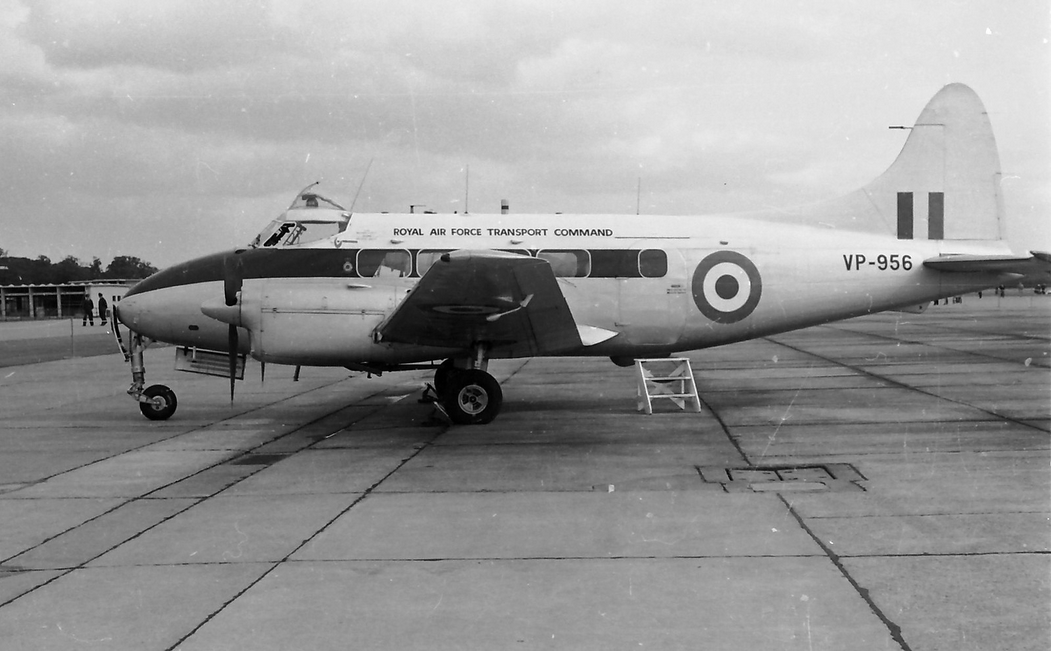
Unknown date and location. Photo: David Whitworth.

At Greenham Common - July 6th 1974. Photo: George Woods.

Waiting for the fire dump at Manston? Date unknown. Photo: Gerrit Kok.
Last edited by OUAQUKGF Ops; 4th Oct 2023 at 22:31. Reason: Grammar
Post Script
Northolt based Convair C-131s Samaritan 55291 at Bovingdon undated. Photo: Arthur Pearcy.
This aircraft crashed, with heavy loss of life, on take-off from Munich, West Germany on December 17th 1960.


Photo: Baaa

Photo: Baaa
https://en.wikipedia.org/wiki/1960_Munich_C-131_crash
Last edited by OUAQUKGF Ops; 16th Jun 2023 at 13:42. Reason: Adding Link
The Aldbury Accident
Vickers Valetta T3 WJ474 of No 2 Air Navigation School, Thorney Island. January 6th 1954.
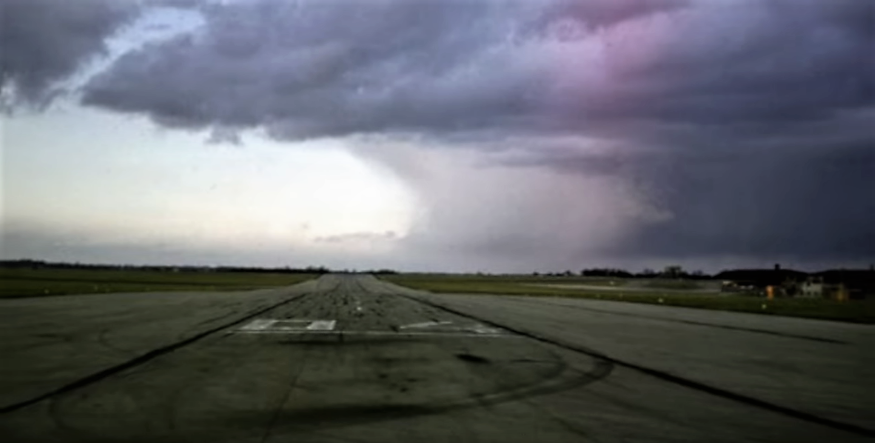
Image: William Schneider
I've not had sight of the Accident Report so the scene will be set by contemporary Press Reports and extracts from Hansard.
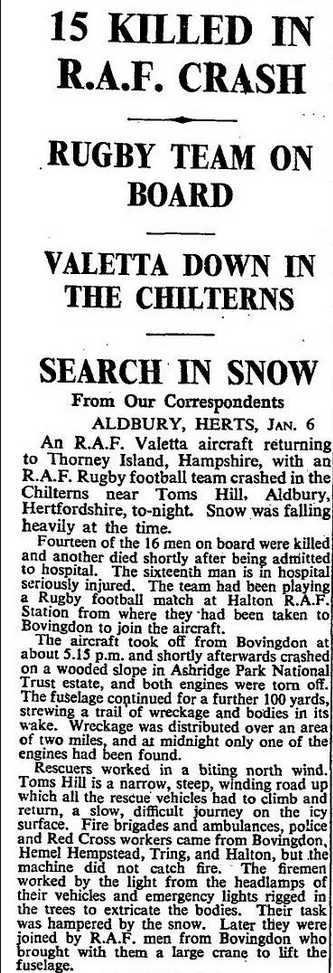

The Inquest opened at Berkhamsted on January 8th 1954
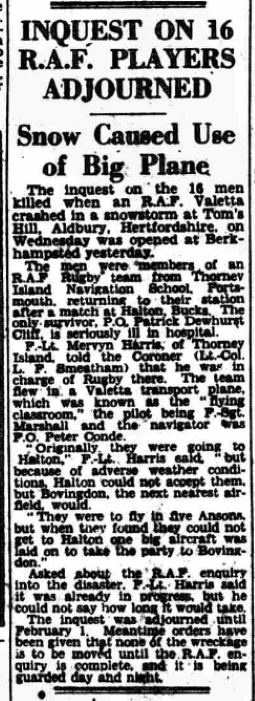
This last Birmingham Post January 9th 1954 (BNA)
The Inquest resumed on March 1st 1954
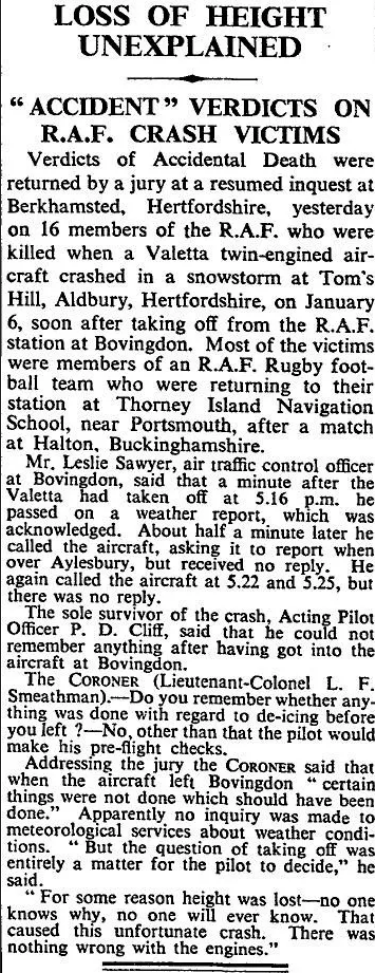

Birmingham Post March 2nd 1954 (BNA)
Acknowledgements to 'Warmtoast' for most of these extracts.
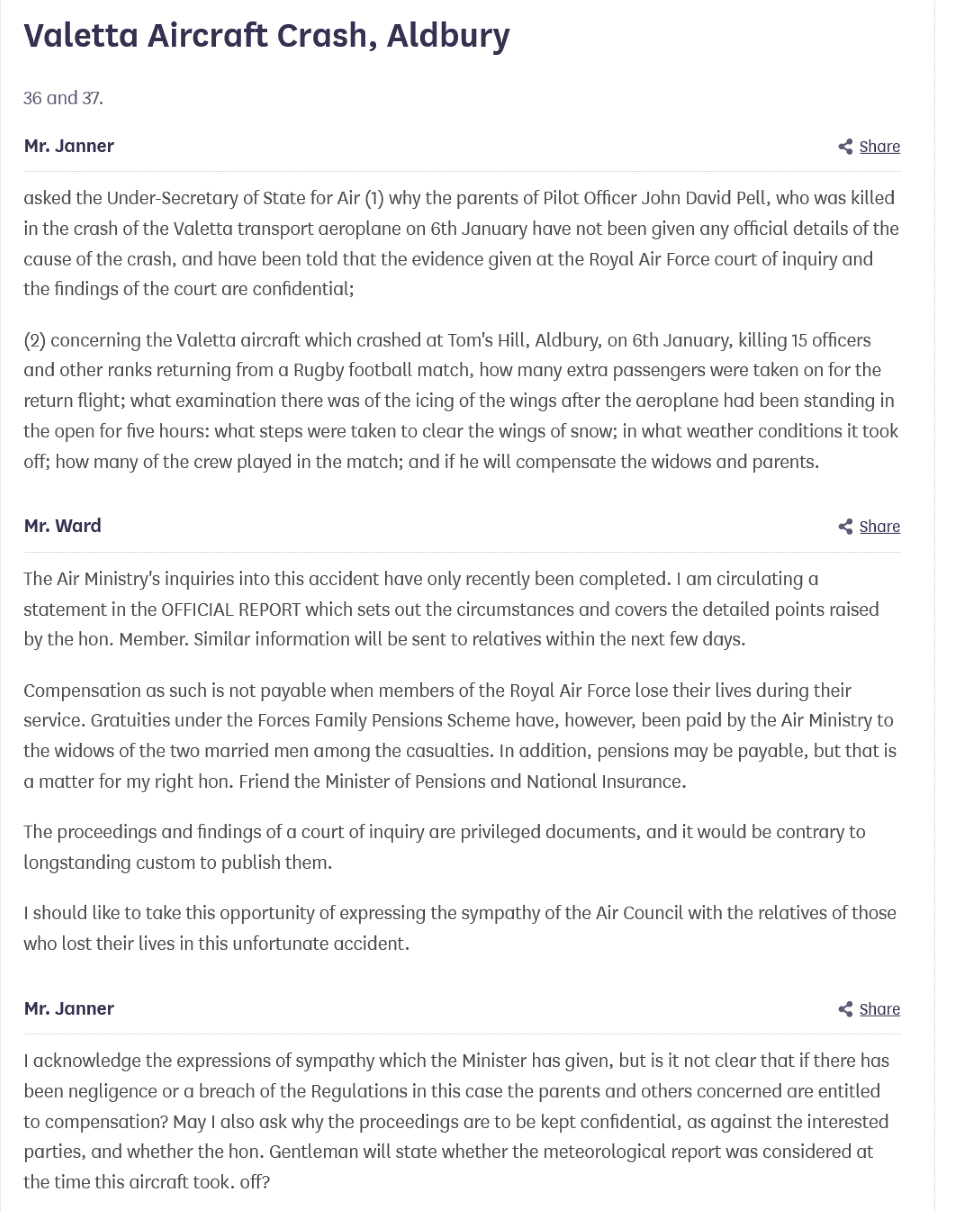
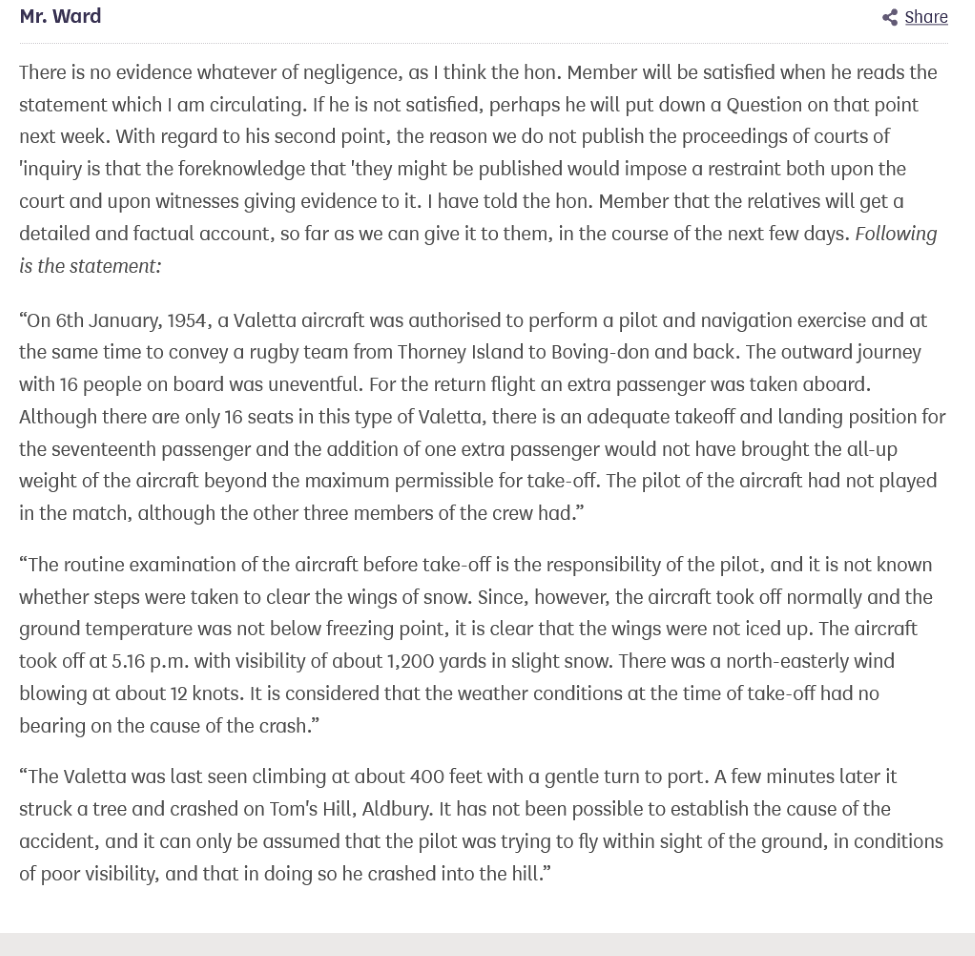
Hansard March 10th 1954
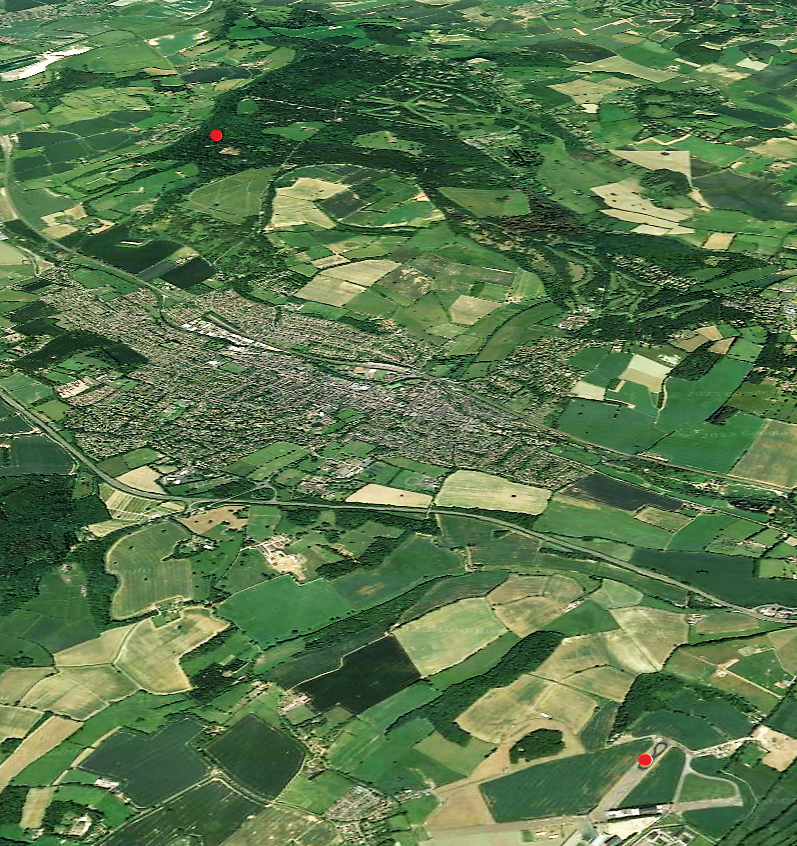
Bovingdon Airfield (535 ft) lower right. Tom's Hill, Aldbury (Impact at 680 ft) upper left. Departure R/W 04. Distance with the left turn approx 6 Statute Miles.
Northchurch and Berkhamsted (High Street at 374 ft ) lying in The Bulbourne Valley. Part of the Chiltern Escarpment which slopes down to The Vale of Aylesbury in the north-west.
I've not been able to find any RAF charts with Spot heights. However out of interest I've included a USAF chart from 1953. To this I have added a small red dot at Moneybury Hill 774 ft which is adjacent to Tom's Hill and not marked.
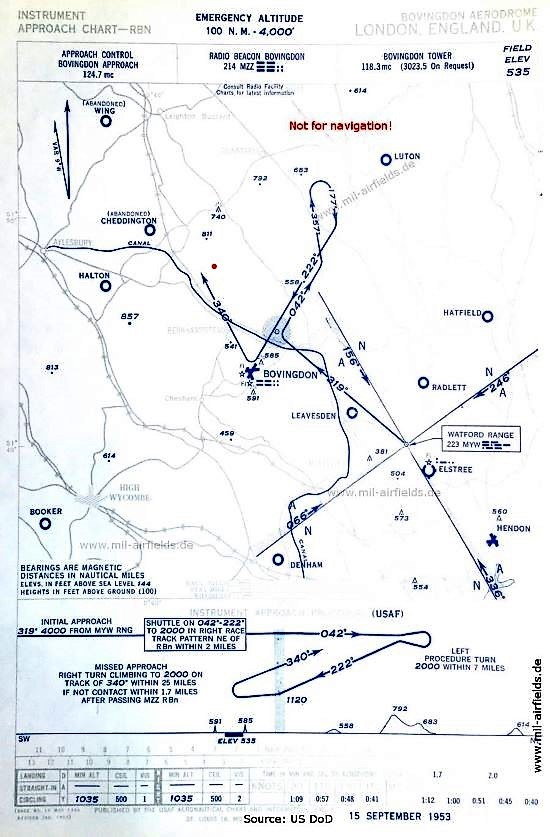
Incidentally the highest point in The Chilterns is at Haddington Hill (875 ft) south-east of Halton . It seems that the compiler of this chart has transposed his figures.....

It is hoped that a more permanent Memorial will be erected at the crash site.

Image: William Schneider
I've not had sight of the Accident Report so the scene will be set by contemporary Press Reports and extracts from Hansard.
The Inquest opened at Berkhamsted on January 8th 1954

This last Birmingham Post January 9th 1954 (BNA)
The Inquest resumed on March 1st 1954

Birmingham Post March 2nd 1954 (BNA)
Acknowledgements to 'Warmtoast' for most of these extracts.


Hansard March 10th 1954

Bovingdon Airfield (535 ft) lower right. Tom's Hill, Aldbury (Impact at 680 ft) upper left. Departure R/W 04. Distance with the left turn approx 6 Statute Miles.
Northchurch and Berkhamsted (High Street at 374 ft ) lying in The Bulbourne Valley. Part of the Chiltern Escarpment which slopes down to The Vale of Aylesbury in the north-west.
I've not been able to find any RAF charts with Spot heights. However out of interest I've included a USAF chart from 1953. To this I have added a small red dot at Moneybury Hill 774 ft which is adjacent to Tom's Hill and not marked.

Incidentally the highest point in The Chilterns is at Haddington Hill (875 ft) south-east of Halton . It seems that the compiler of this chart has transposed his figures.....

It is hoped that a more permanent Memorial will be erected at the crash site.
Last edited by OUAQUKGF Ops; 2nd Jul 2023 at 12:51.
The Aldbury Accident
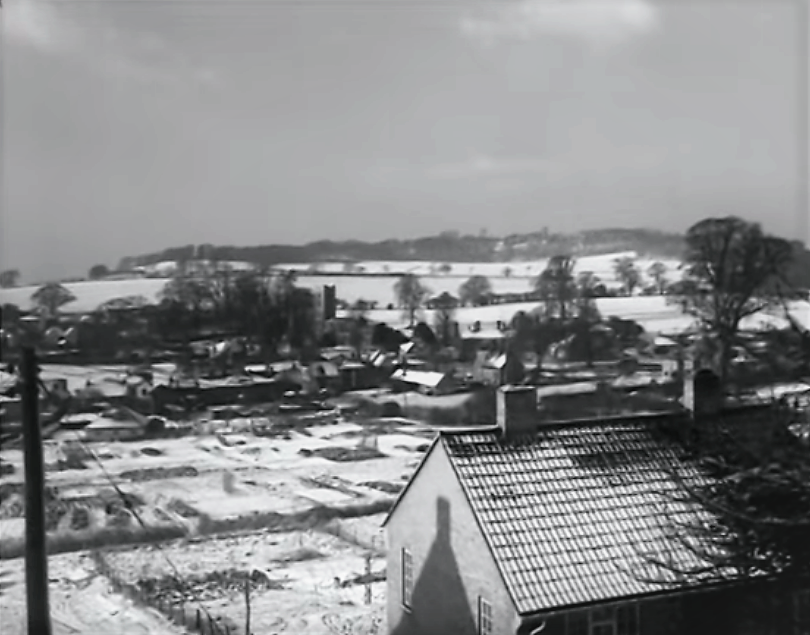
Aldbury Village. Image thought to have been taken on January 7th 1954
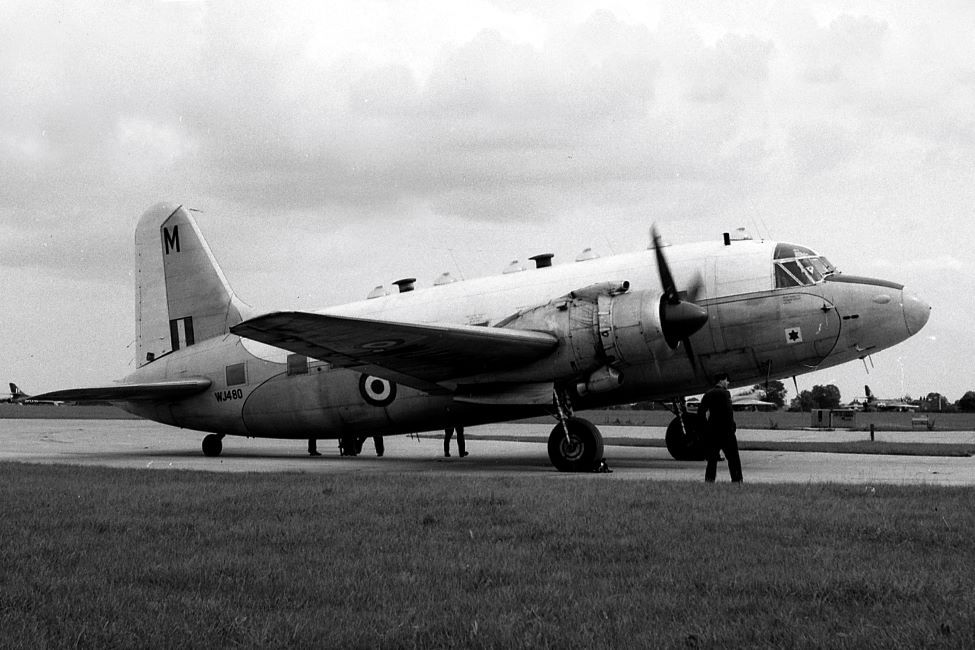
Vickers Valetta T3 of No 2 Air Navigation School Thorney Island pictured circa 1960
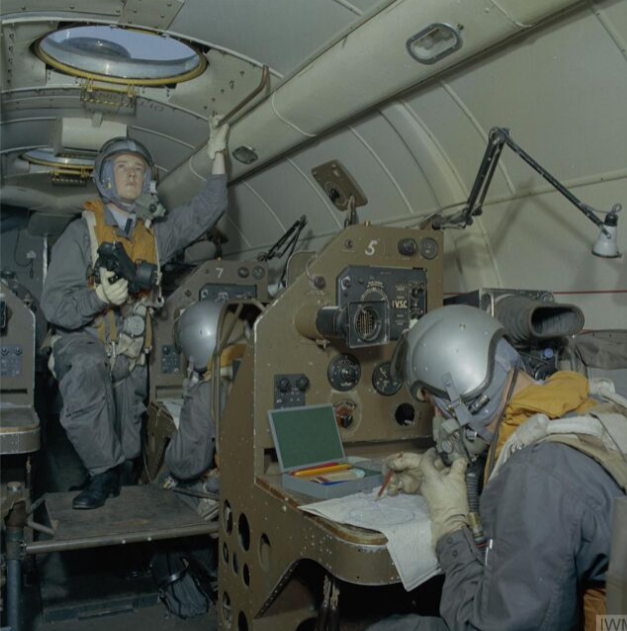
Valetta T3 of No 2 Air Navigation School Thorney Island (1958) Configured for 12 Students. Photo: Imperial War Museum.
Of the victims of this accident all except the pilot Flt Sgt Ralph Marshall and Flt Lt P. Clare who hitched a lift from Bovingdon had played in the Rugby match at Halton. Fate works in mysterious ways. In 2017 Retired Wing Commander Patrick Cliff OBE related to Paul Aylott how as the junior officer he was displaced by the extra passenger and so seated himself on the main spar. He attributes his survival to this stroke of good fortune.

Looking south-south-west towards Aldbury Church (at 466 ft) in the middle distance with Tom's Hill highlighted. In the distance and out of sight left is Cow Roast and the start of the Bulbourne Valley.
Photo: National Trust
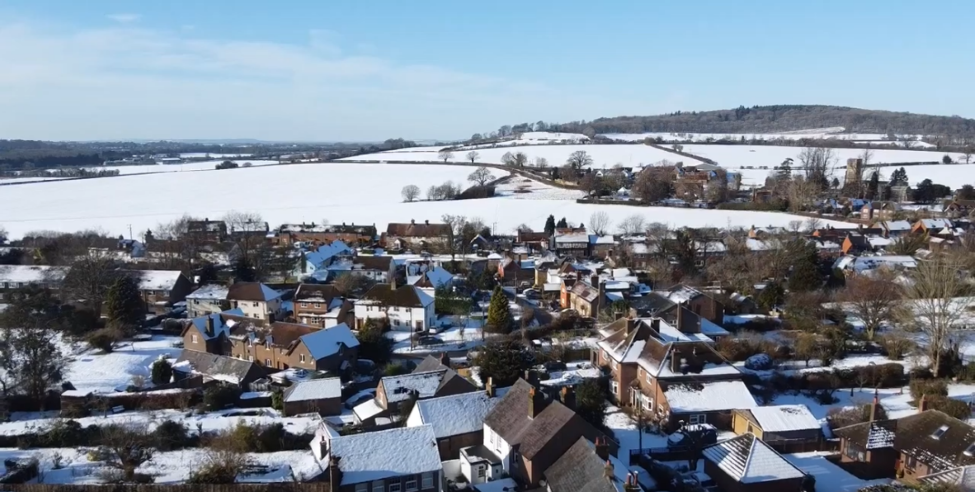
Aldbury looking north-west from the bottom of Tom's Hill. Tring in the distance to the left. Beyond, the Escarpment sloping down towards the Vale and Aylesbury. It would appear that the Valetta was heading for Aylesbury before turning south to route direct to Thorney Island. The High ground to the right is Aldbury Nowers (728 ft) Photo: Paul Foreman.

Crash Site

It is all well and good to try and paint a picture from old press reports and Hansard. The aircraft was last seen to make a gentle turn to port at about 400 feet. One assumes that this observation was made on departure by ATC at Bovingdon but we don't know for sure. If it was, that would place the Valetta at a height of approximately 950 ft amsl.
It was suggested that the Pilot then lost height in order to see the ground. I find this rather unlikely considering that the Pilot would have been Instrument Rated and that it was dark (Sunset at 1600 hrs that day) and on departure, snowing lightly. However in the unlikely event that he had decided to follow the LMS Railway Line from Berkhamsted this is roughly the direction in which he would have flown. Incidentally the Grand Union Canal runs almost in parallel with the railway and would show up better in contrast with snow on the ground. In conclusion if the pilot was attempting to follow the railway line/canal it would be reasonable to think that he would keep these features to his port side, concentrating his vision thus. But note the presence of high ground on his starboard side, typically Norcot Hill (yellow dot) 620 ft. The distance from the railway at Cow Roast (at 413 ft) to the point of impact at 680 ft (red dot) is 1.15 statute miles. Note how the railway starts to curve north-north-west for a short distance at this point. Sadly it seems the flight lasted approx 5 minutes. There is a very good image of the railway and canal posted by Warmtoast on the first page of this thread (and that's going back a bit !). Just click on 'First' at the bottom right of screen. In retrospect I think this is all rather fanciful. Perhaps the aircraft was continuing a wide gentle turn towards Aylesbury in the west when it encountered a heavy snow flurry, with the Pilot experiencing whiteout and perhaps, because of this, loosing what little height he already had thus hitting the trees?

The road to Tom's Hill is narrow in places. Photo: Rob Farrow geograph

Quite steep too - I believe they have cycle time trials here these days. Photo: Rob Farrow geograph

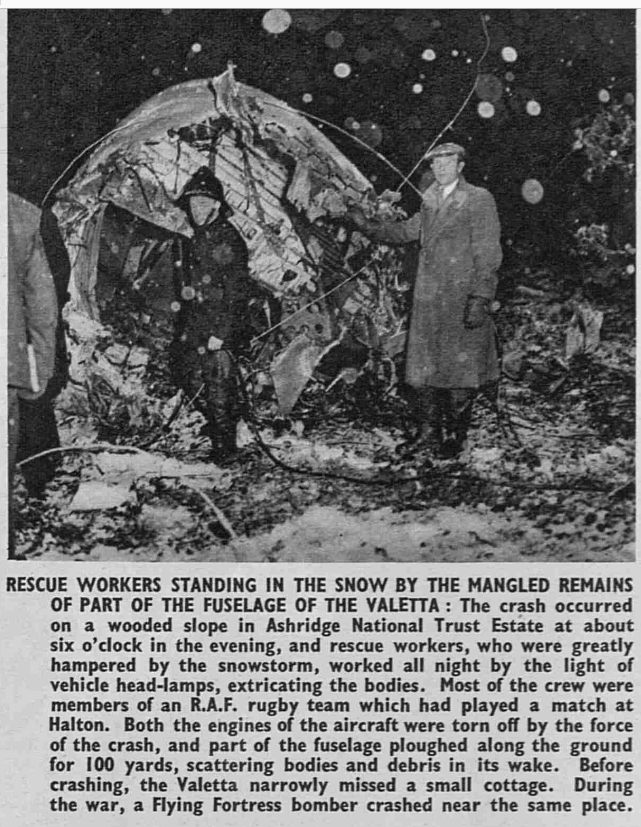
The Sphere January 16th 1954 (BNA)

Old Copse Lodge - Looking to the north-east. Home of the Gamekeeper. The crash site was a couple of hundred yards away to the south-east.
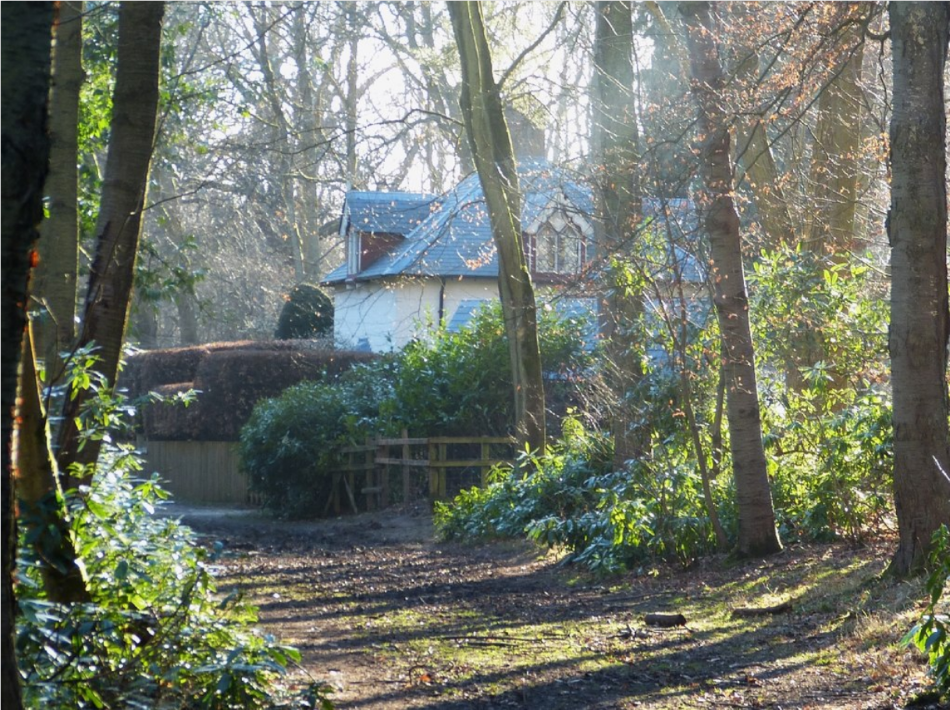
Old Copse Lodge looking to the south-west. The home of generations of Gamekeepers. Constructed in the early 19th century as a Lodge on the west side of Ashridge Park serving the road that ran from Ashridge House to Aldbury and Tring. Photo: Rob Farrow geograph
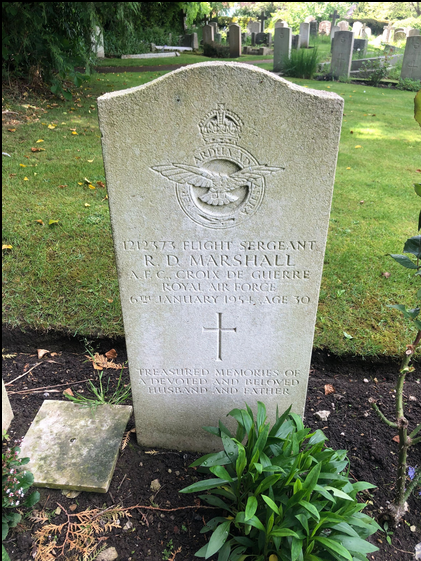
Several members of the Rugby Team, together with their pilot, are resting in the Churchyard of St Michael, Halton.
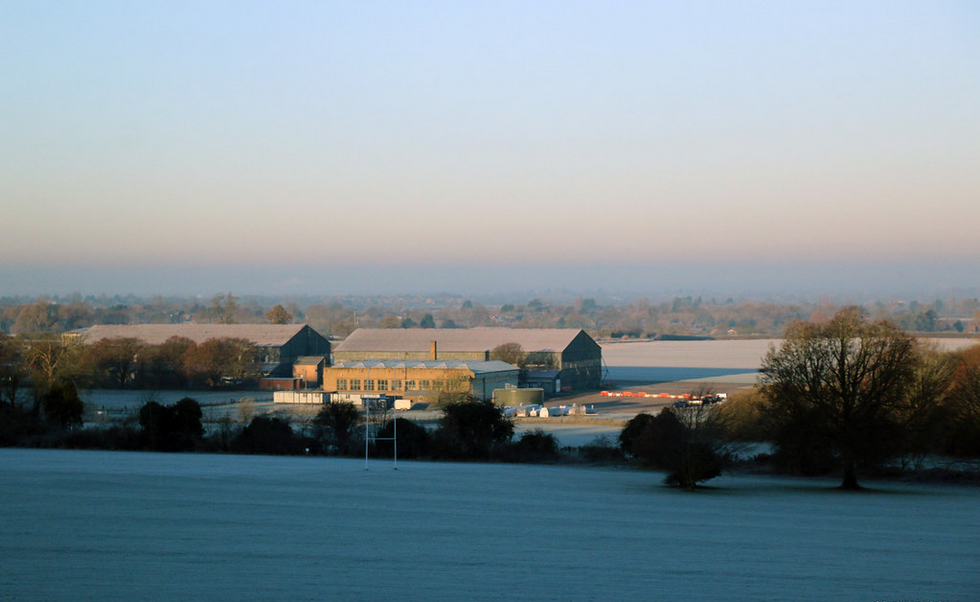
Kevin Slade
Further reading: https://www.hertsmemories.org.uk/con...letta-accident
Last edited by OUAQUKGF Ops; 4th Jul 2023 at 09:38. Reason: Amendments
Ref VP956; I flew in VP958 from Bovingdon on 13 Jul '65 whilst we were doing evening gliding. The SDO decided to do a couple of circuits for currency and invited the cadets along too.
Other notable flights I logged from Bovingdon that year: I flew the first ever glider launch from Bovingdon on 21 Jun '65 in Mk3 WT871, then on 19 Sep the CFI told me to "take '150 (Sedbergh XN150) solo and don't come back for 15 minutes" meaning he was telling me to get my soaring certificate (BGA 'C' certificate) which is what I did.
I don't think the crew of the passing Britannia/CL44 saw me when I inadvertantly climbed into controlled airspace.
Other notable flights I logged from Bovingdon that year: I flew the first ever glider launch from Bovingdon on 21 Jun '65 in Mk3 WT871, then on 19 Sep the CFI told me to "take '150 (Sedbergh XN150) solo and don't come back for 15 minutes" meaning he was telling me to get my soaring certificate (BGA 'C' certificate) which is what I did.
I don't think the crew of the passing Britannia/CL44 saw me when I inadvertantly climbed into controlled airspace.
Last edited by chevvron; 1st Jul 2023 at 09:41.
Exiting days chevvron. I was stationed at Bovingdon before your gliders appeared and I never got near Fighter Coms Devon when I was on Coastal Com, but I did eventually fly one of the CAA's Doves, G-ANUT when I did the Instrument CAA Examiners Course at Stansted in 1975.



